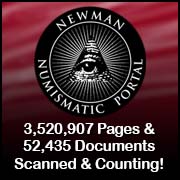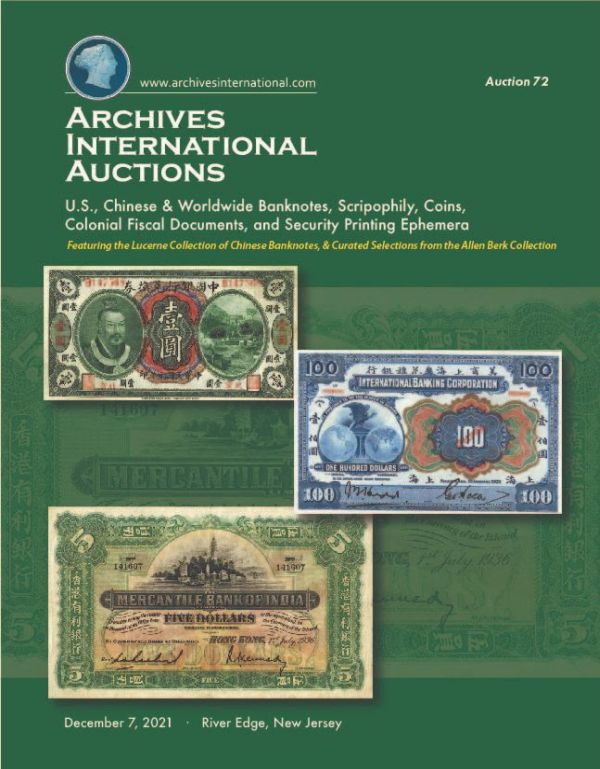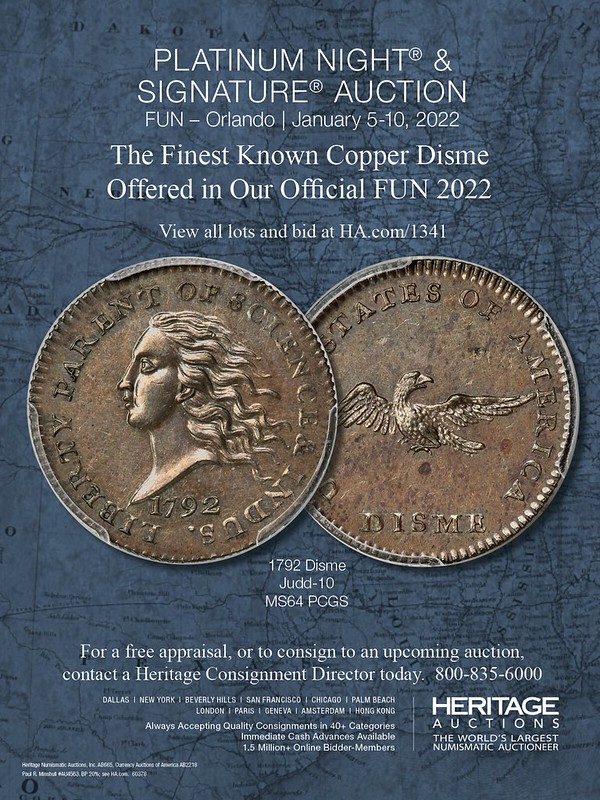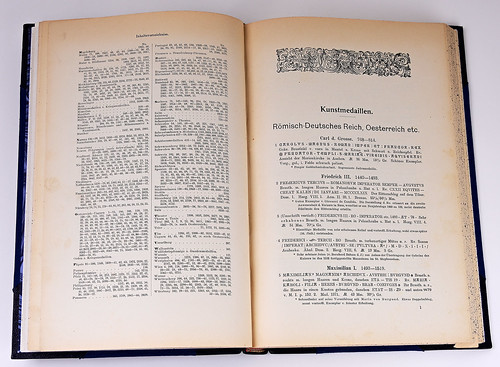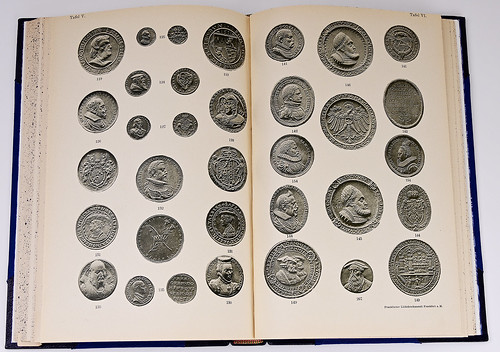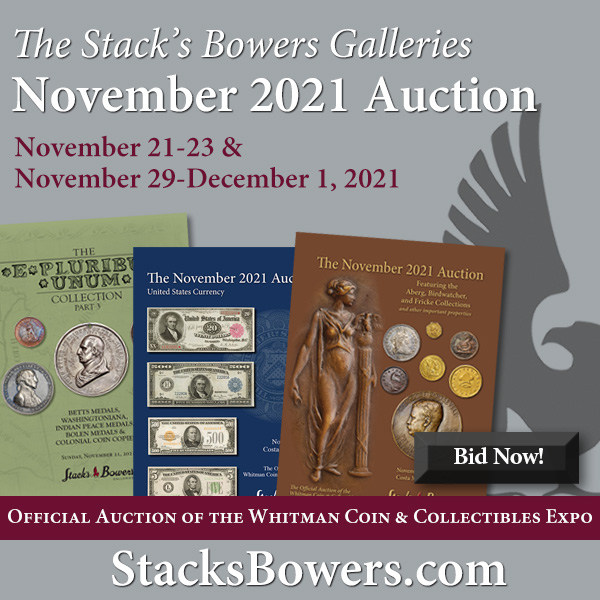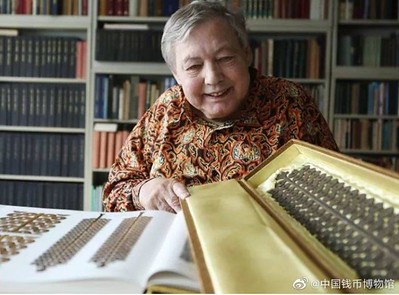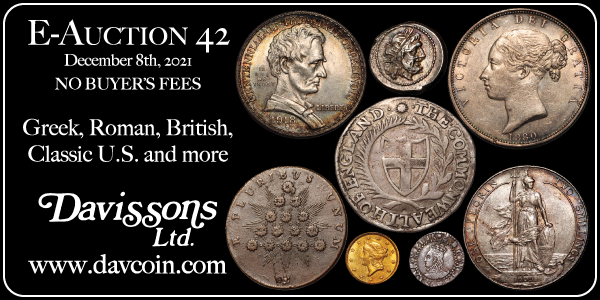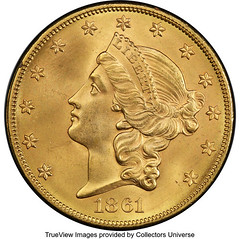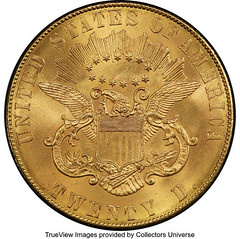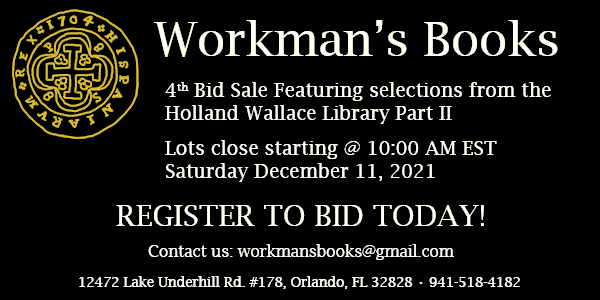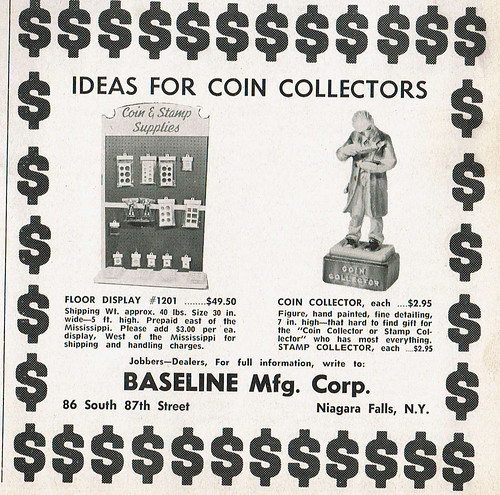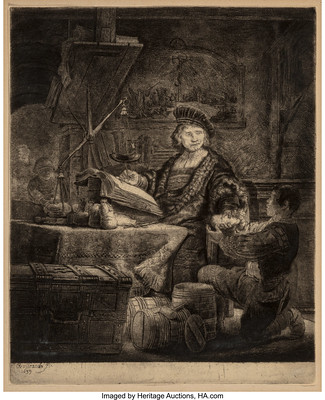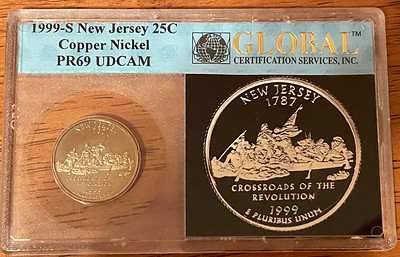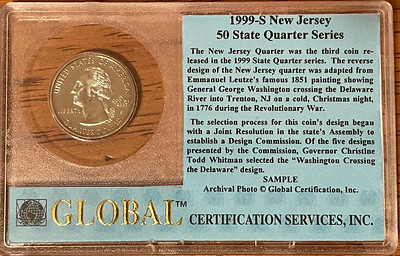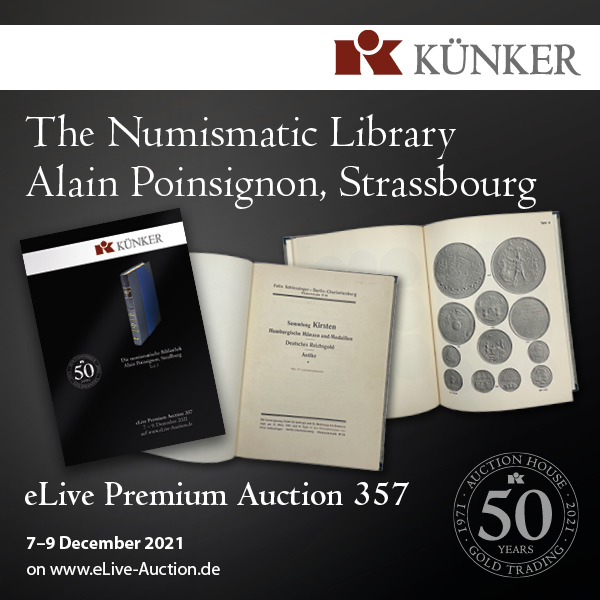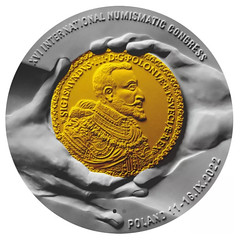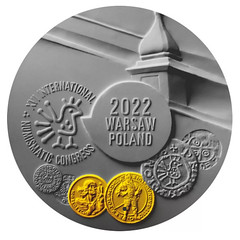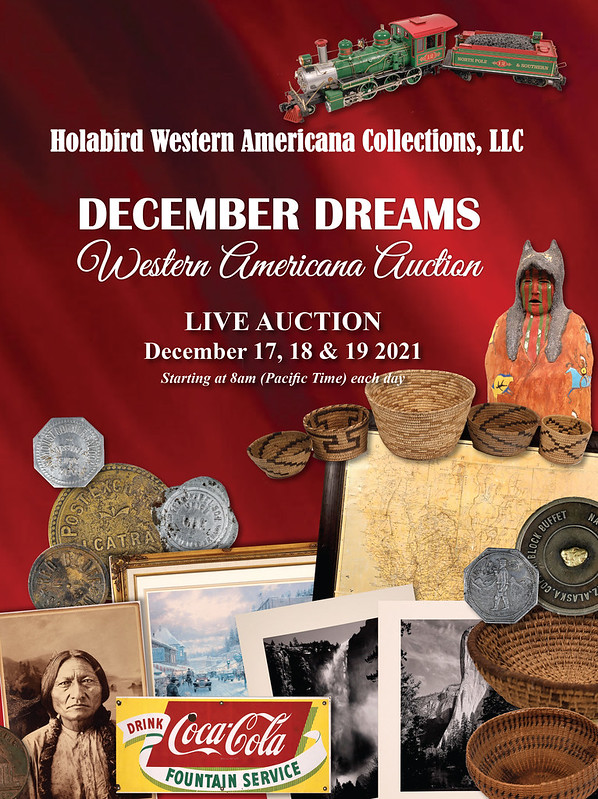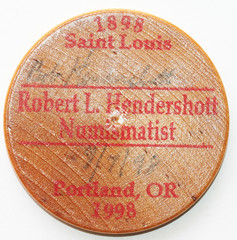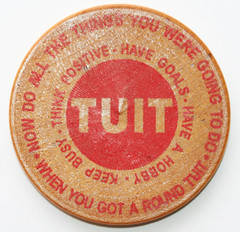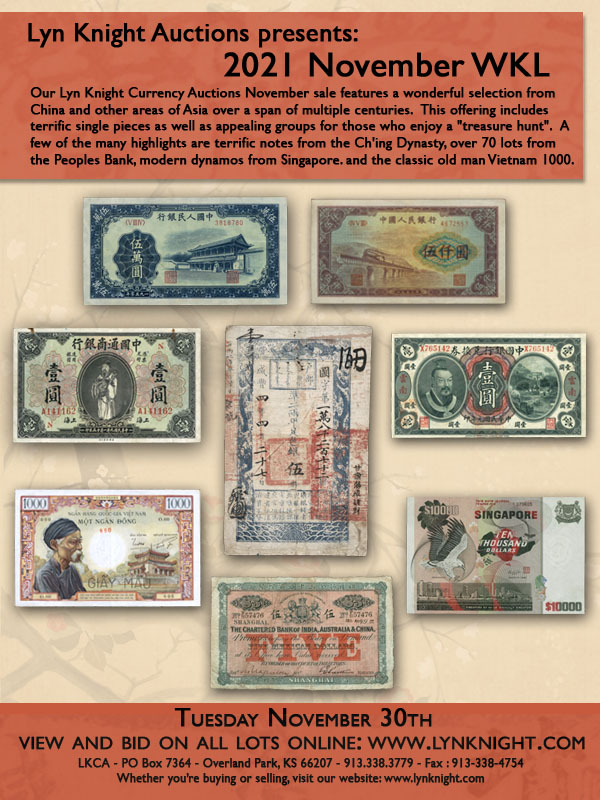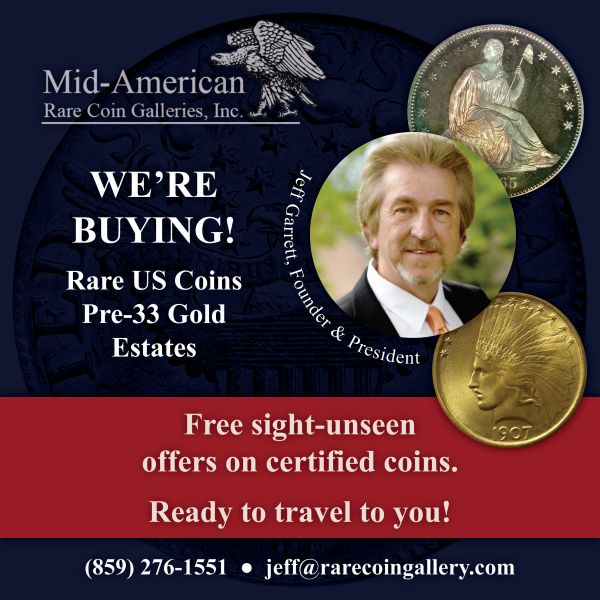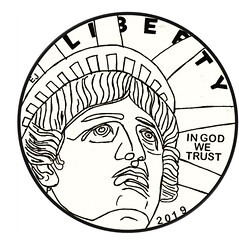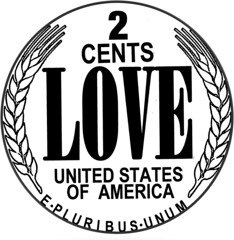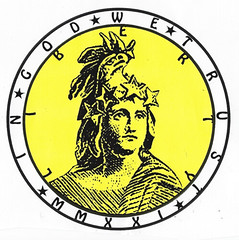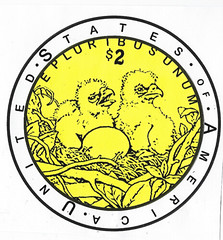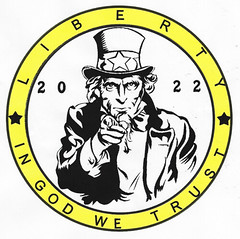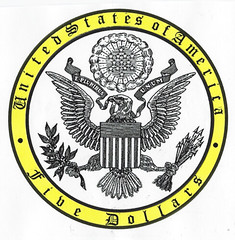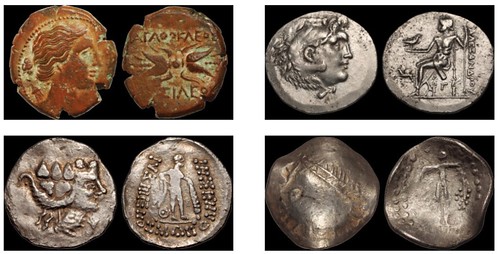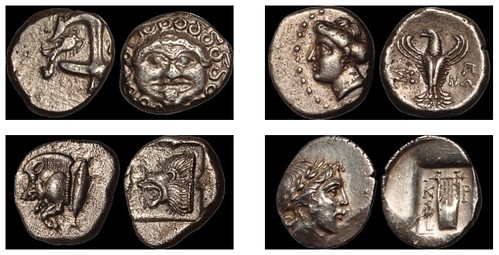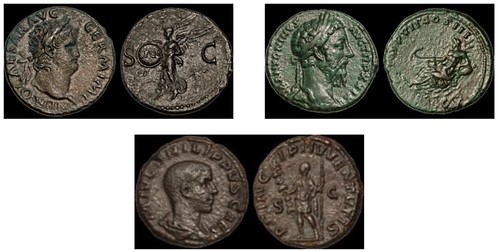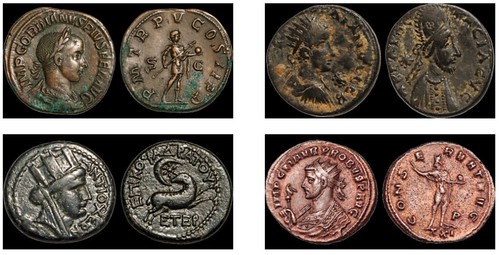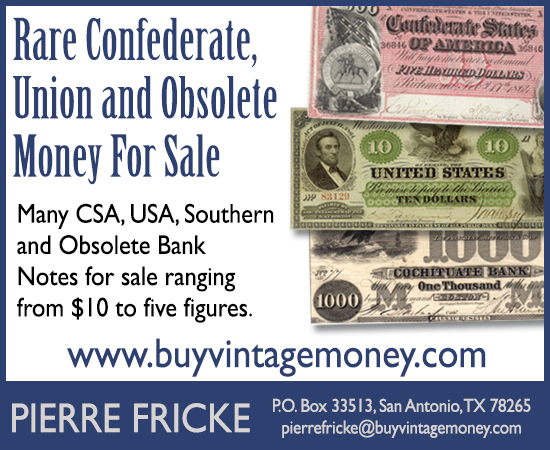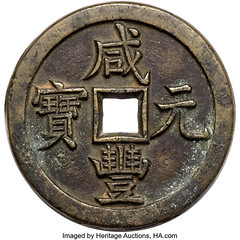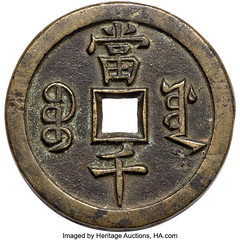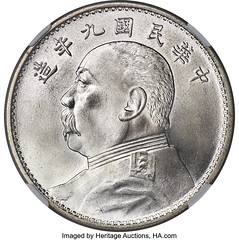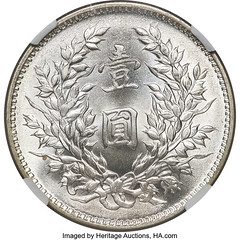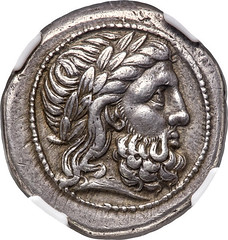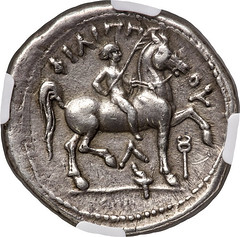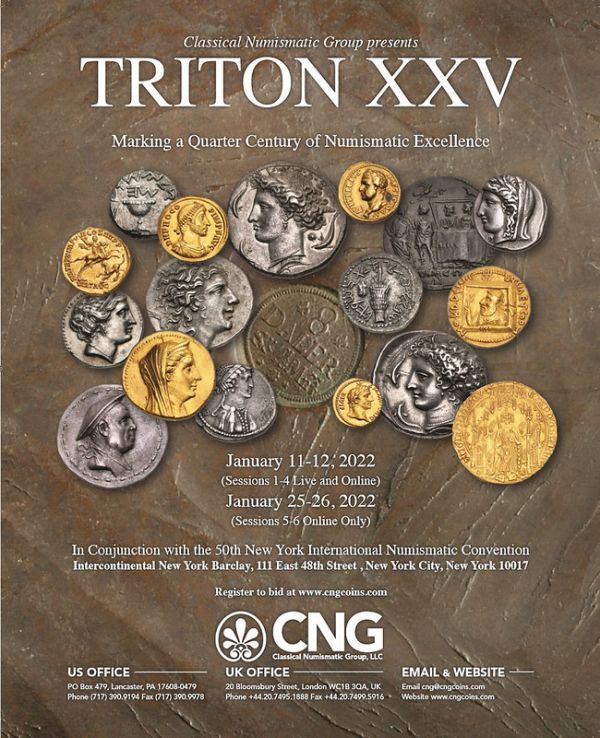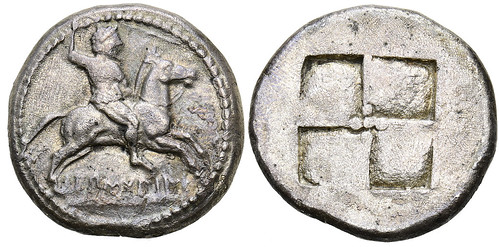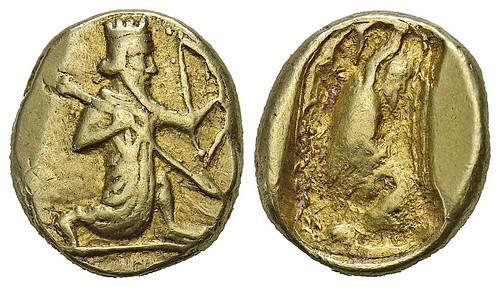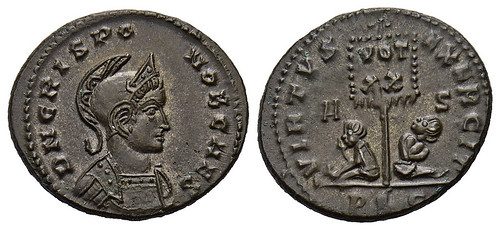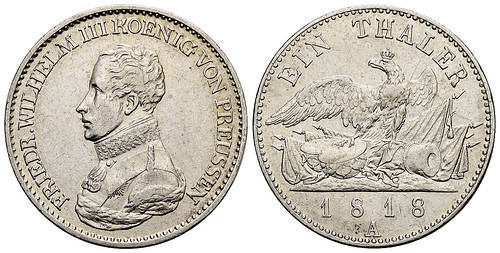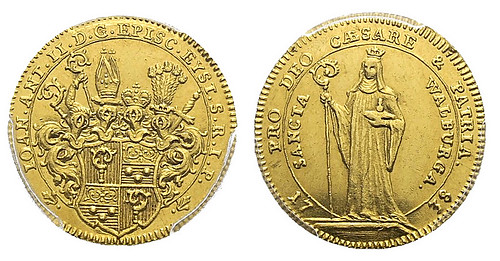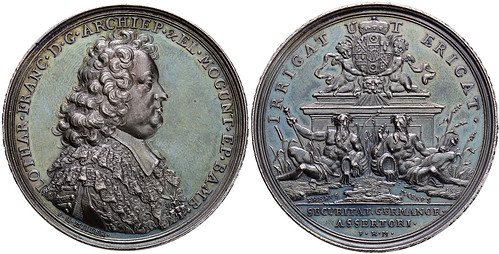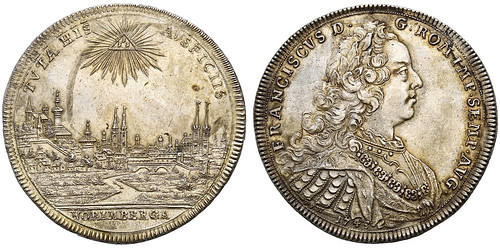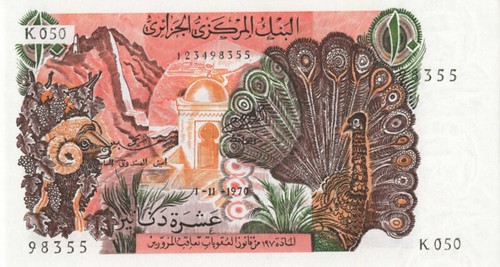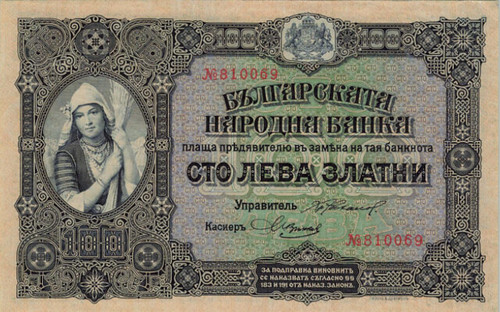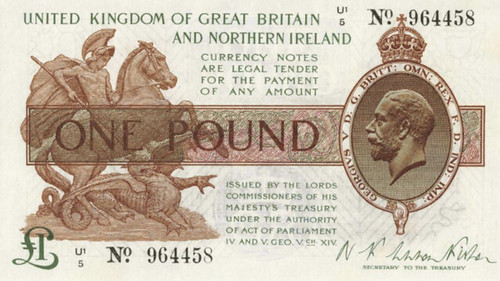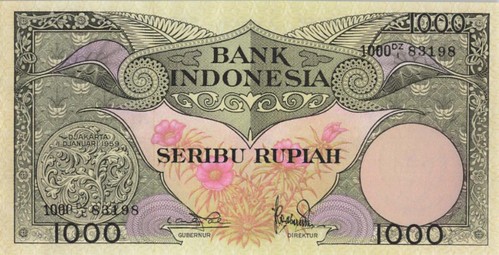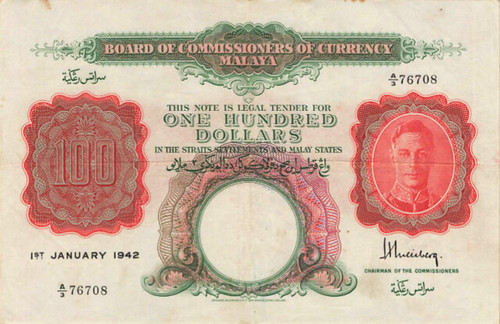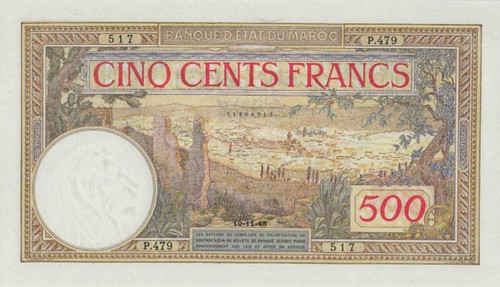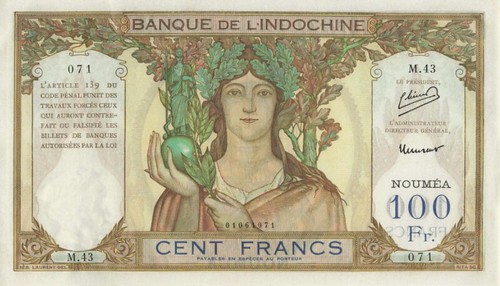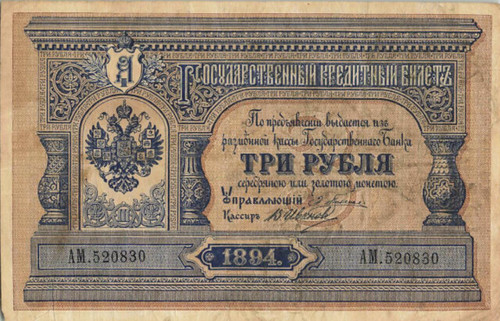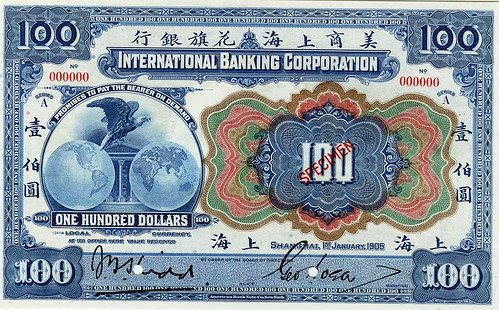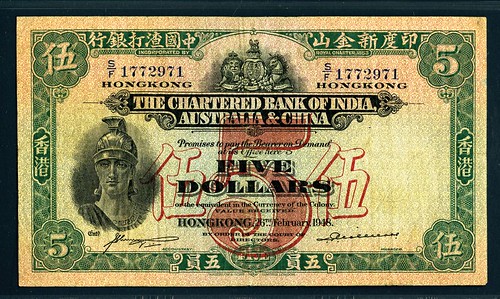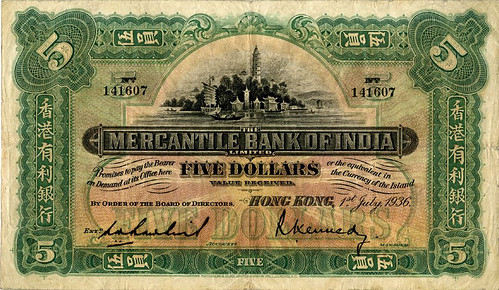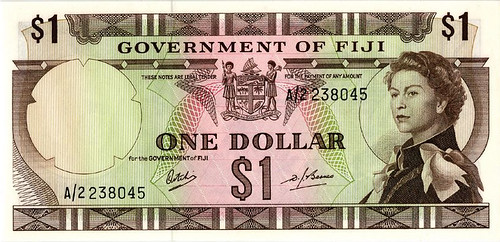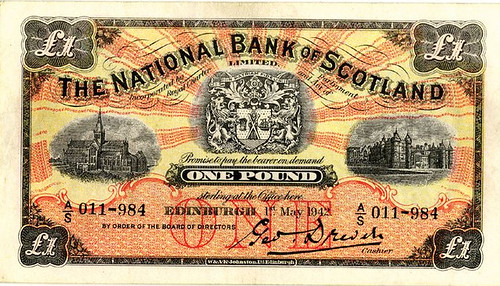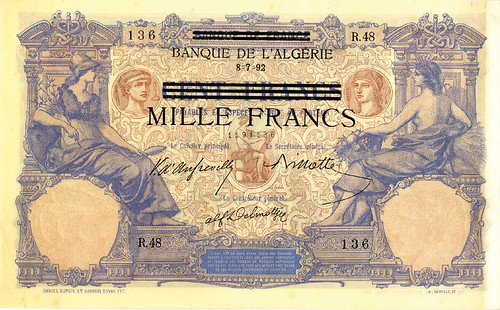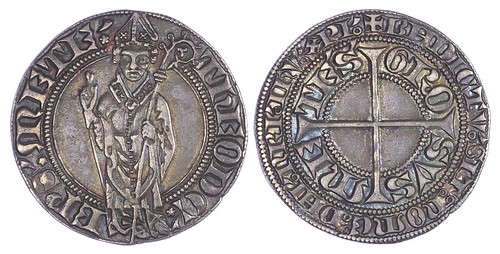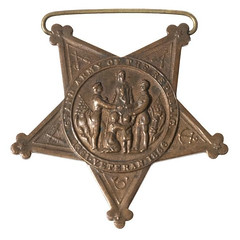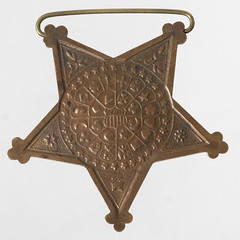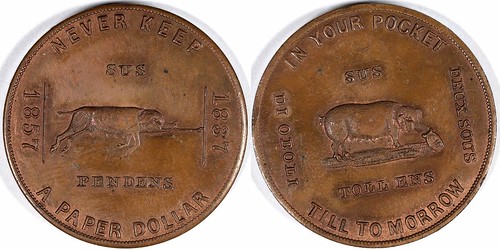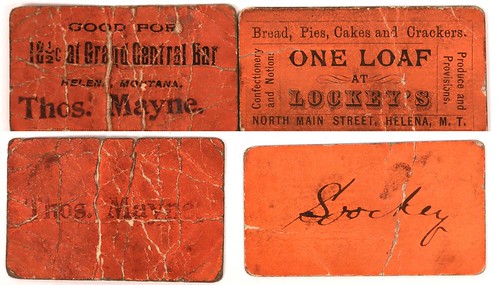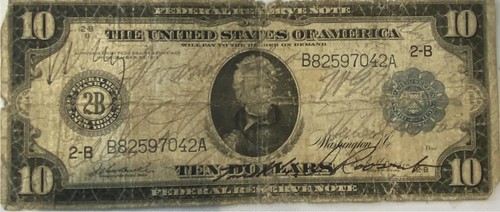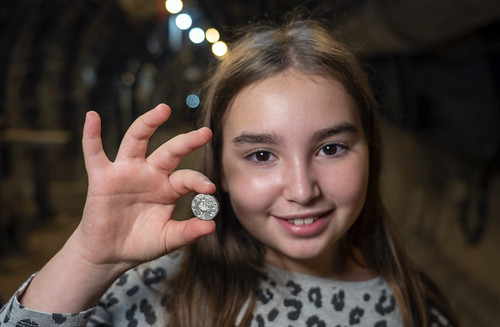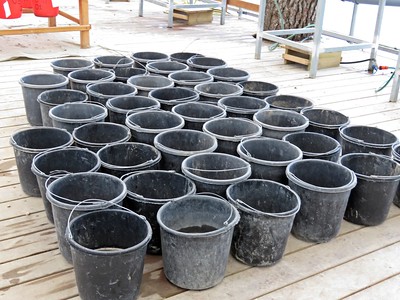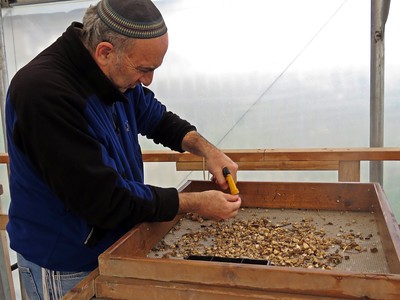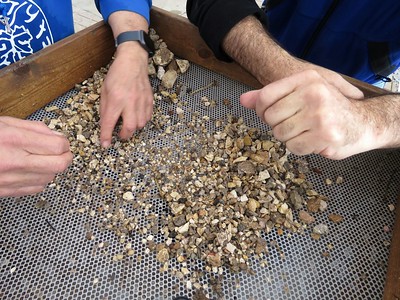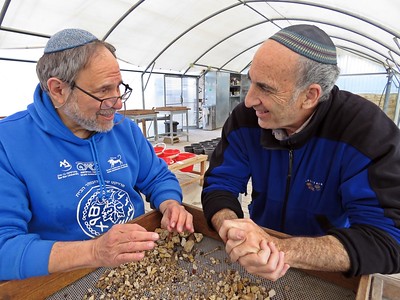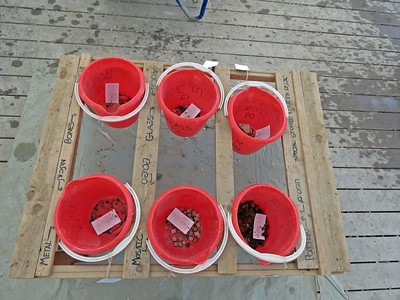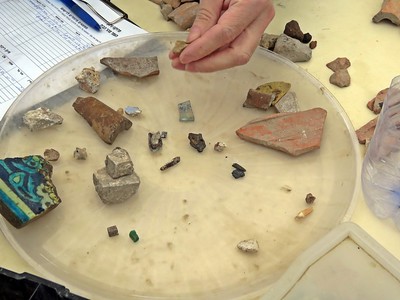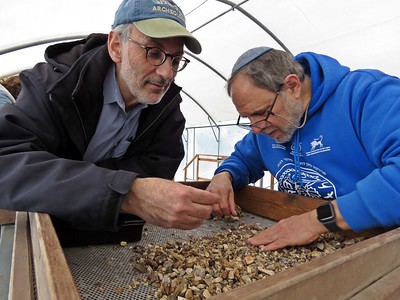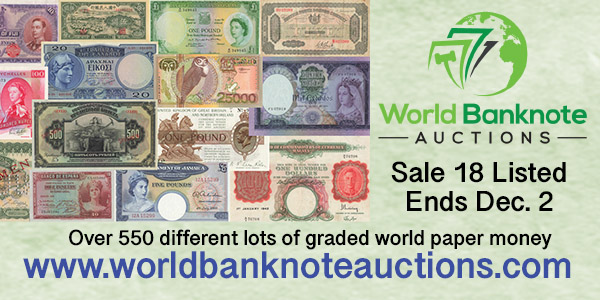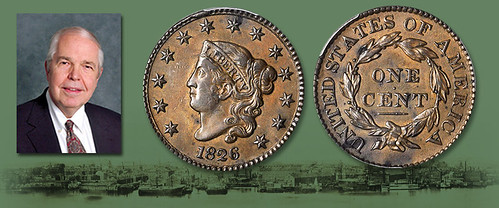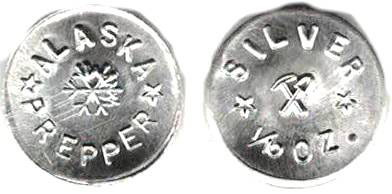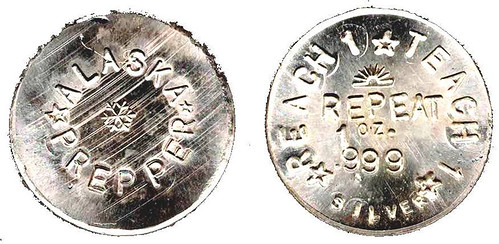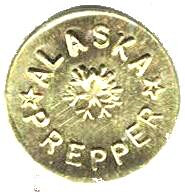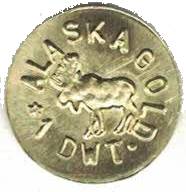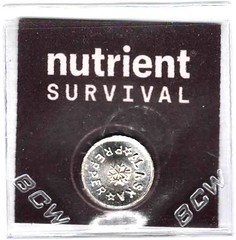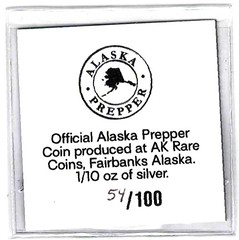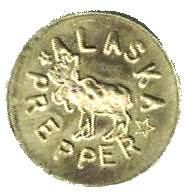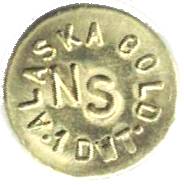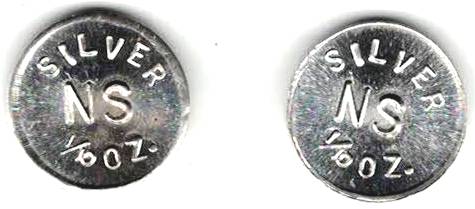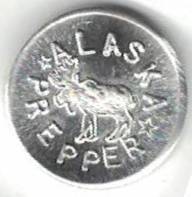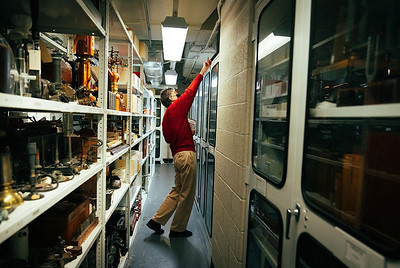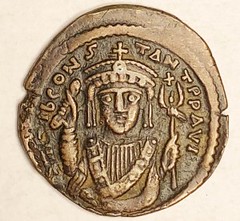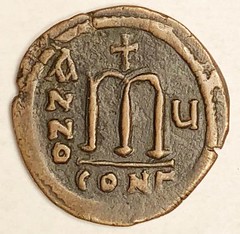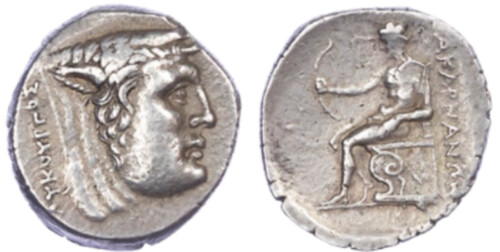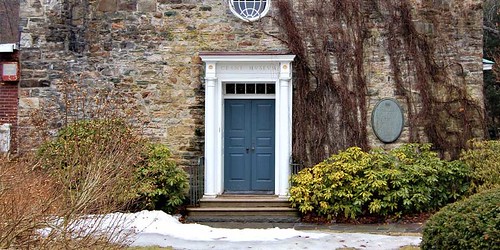
Visit our NBS Sponsors



|
The Numismatic Bibliomania Society is a non-profit association devoted to the study and enjoyment of numismatic literature. For more information please see our web site at coinbooks.org SubscriptionsThose wishing to become new E-Sylum subscribers (or wishing to Unsubscribe) can go to the following web page link MembershipThere is a membership application available on the web site Membership Application To join, print the application and return it with your check to the address printed on the application. Print/Digital membership is $40 to addresses in the U.S., and $60 elsewhere. A digital-only membership is available for $25. For those without web access, write to: Charles Heck, Treasurer AsylumFor Asylum mailing address changes and other membership questions, contact Chuck at this email address: treasurer@coinbooks.org SubmissionsTo submit items for publication in The E-Sylum, write to the Editor at this address: whomren@gmail.com BUY THE BOOK BEFORE THE COINSale CalendarWatch here for updates! |
- WAYNE'S WORDS: THE E-SYLUM NOVEMBER 28, 2021
- ASYLUM WINTER 2021 ISSUE PUBLISHED
- KOLBE & FANNING ACCEPTING POINSIGNON BIDS
- POINSIGNON LIBRARY, INTERNATIONAL COIN TRADE
- ANS ANNOUNCES PRINT-ON-DEMAND PROGRAM
- NEW BOOK: COMMEMORATIONS OF WASHINGTON
- NEW BOOK: FAUSTINA THE YOUNGER
- NEW BOOK: THE WINCHESTER MINT REPRINT
- ONLINE RESOURCES FOR ANCIENT COINS
- WERNER BURGER (1936-2021)
- CHARLES BARBER LETTER ON ANTHONY PAQUET DIES
- NNP SEEKS LIBRARY TECHNICAL ASSISTANT
- MORE ON HOLLAND WALLACE
- NOTES FROM E-SYLUM READERS: NOVEMBER 28, 2021
- ANS 2022 NUMISMATIC CONGRESS TRAVEL GRANTS
- STACK'S BOWERS PHILADELPHIA GALLERY OPENS
- VOCABULARY TERM: GERMAN-SILVER
- ROBERT LYNN HENDERSHOTT (1898-2005)
- WILLIAM WELLS BROWN, WILDCAT BANKER?
- MORE NEW COIN DESIGN IDEAS
- DAVISSON'S E-AUCTION 42 ANCIENTS
- HERITAGE DECEMBER 2021 HONG KONG SALE
- SELECTIONS FROM KüNKER ELIVE AUCTION 69
- WORLD BANKNOTE AUCTIONS SALE 18 SELECTIONS
- ARCHIVES INTERNATIONAL AUCTION 72 SELECTIONS
- NUMISMATIC NUGGETS: NOVEMBER 28, 2021
- GIRL FINDS 2ND YEAR SILVER SHEKEL IN JERUSALEM
- AARON OPPENHEIM, ARCHEOLOGIST
- PIGGYBANK FULL OF 1826 LARGE CENTS
- ALASKA PREPPER TOKENS
- WHAT IS A MODERN COIN?
- FLOODING THREATENS SMITHSONIAN
- LOOSE CHANGE: NOVEMBER 28, 2021
- FEATURED WEB SITE: CRANE MUSEUM OF PAPERMAKING
Click here to read the thin version on the web
Click here to subscribe
Click here to access the complete archive
To comment or submit articles, reply to whomren@gmail.com
Content presented in The E-Sylum is not necessarily researched or independently fact-checked, and views expressed do not necessarily represent those of the Numismatic Bibliomania Society.
WAYNE'S WORDS: THE E-SYLUM NOVEMBER 28, 2021
 We now have 6,722 subscribers.
No new subscribers this week.
We now have 6,722 subscribers.
No new subscribers this week.
Thank you for reading The E-Sylum. If you enjoy it, please send me the email addresses of friends you think may enjoy it as well and I'll send them a subscription. Contact me at whomren@gmail.com anytime regarding your subscription, or questions, comments or suggestions about our content.
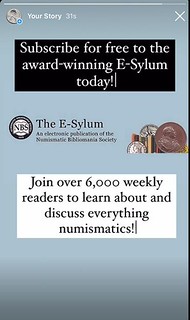 Thanks to Kellen Hoard for promoting us with a Story on his Instagram account.
Thanks also to Martin Kaplan for suggesting it!
Thanks to Kellen Hoard for promoting us with a Story on his Instagram account.
Thanks also to Martin Kaplan for suggesting it!
This week we open with a new issue of our print publication, updates on the Poinsignon library sale, three new books, online sources for ancient coin research, updates from the Newman Numismatic Portal, and more.
Other topics this week include the Winchester Mint, Werner Burger, Charles Barber, Anthony Paquet, Holland Wallace, Bob Hendershott, the 2022 Warsaw Numismatic Congress, German silver, wildcat banking, new coin design ideas, LOTS of auction previews, a 2nd year silver shekel, 1826 Large Cents, Alaska prepper tokens, and the Crane Museum of Papermaking.
To learn more about the international coin trade, Faustina the Younger, Wildwinds, Miquel Pratt, William Wells Brown, ANS Travel Grants, Mother coins, world banknotes, the 1907 Brenner Lincoln plaque, ultra-modern coins, psychophysics in numismatics and the man-headed bull, read on. Have a great week, everyone!
Wayne Homren
Editor, The E-Sylum
THE BOOK BAZARRE
ASYLUM WINTER 2021 ISSUE PUBLISHED
The Winter 2021 issue of The Asylum is on the way from our sponsor, the Numismatic Bibliomania Society. Maria Fanning edits our print journal, and she submitted this report. -Editor
The Asylum Winter Issue
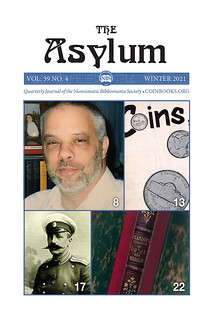 The Asylum's Winter 2021 issue is on its way to NBS members. In this issue, we grieve the loss of Tom Fort with an obituary by Pete Smith, a bibliography compiled by David Fanning, and remembrances by NBS members and friends.
The Asylum's Winter 2021 issue is on its way to NBS members. In this issue, we grieve the loss of Tom Fort with an obituary by Pete Smith, a bibliography compiled by David Fanning, and remembrances by NBS members and friends.
Also in this issue:
- Message from NBS President Tom Harrison
- The Origin of Coins Magazine By David W. Lange
- The Legacy of Grand Duke Georgii Mikhailovich By David F. Fanning
- ASSOCIATIONS: Autographs, Annotations, Inscriptions—Charles Ira Bushnell's Flandin's Catalogue of Coins and Medals: Part I: The Catalog and its Creator By Joel J. Orosz
NBS Membership Renewal Time!
Please renew your membership in the NBS to continue receiving The Asylum in 2022. Go to coinbooks.org to pay by PayPal or download a membership form today. Your current expiration date is printed to the right of your name on your subscription envelope, which should be arriving soon.
Remember, while The E-Sylum is free to all, only paid members of the Numismatic Bibliomania Society receive our print journal, The Asylum. Print/Digital membership is $40 to addresses in the U.S., and $60 elsewhere. A digital-only membership is available for $25. -Editor
To join NBS or renew your membership, see:
https://www.coinbooks.org/about/membership.html
KOLBE & FANNING ACCEPTING POINSIGNON BIDS
Kolbe & Fanning are accepting bids for the upcoming Künker Poinsignon Library sale. -Editor
Künker's December 7–9 Sale of the Poinsignon Library
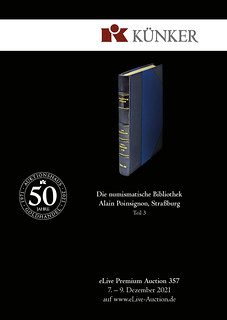 Kolbe & Fanning Numismatic Booksellers are cooperating with Fritz Rudolf Künker, of Osnabrück, Germany, in their sale by auction of the third part of the numismatic library of Alain Poinsignon of Strasbourg. This 1970-lot sale is devoted exclusively to numismatic sale catalogues, and constitutes one of the truly great offerings of these important research tools. The eLive Premium Auction will be held on December 7–9, 2021, and the 497-page PDF catalogue can be
downloaded here.
Kolbe & Fanning Numismatic Booksellers are cooperating with Fritz Rudolf Künker, of Osnabrück, Germany, in their sale by auction of the third part of the numismatic library of Alain Poinsignon of Strasbourg. This 1970-lot sale is devoted exclusively to numismatic sale catalogues, and constitutes one of the truly great offerings of these important research tools. The eLive Premium Auction will be held on December 7–9, 2021, and the 497-page PDF catalogue can be
downloaded here.
Kolbe & Fanning clients who wish to participate in the Poinsignon sale are invited to place their bids through us at no additional charge. We will be participating throughout the entire three-day sale and will handle bidding for our clients as well as for ourselves. The buyer's premium of 20% will be the same for bidders participating through Kolbe & Fanning as it is for those participating directly through Künker. Any items purchased by us on behalf of clients will be sent to us in Ohio and forwarded from our office. This will allow Kolbe & Fanning clients to take advantage of lower international shipping costs and simplified customs clearance.
The Poinsignon Library is especially important for European coin catalogues featuring ancient and world coins and medals. The Künker firm has prepared an excellent and informative catalogue and has provided a standard, very low, opening bid for each lot, choosing to allow the market to determine the prices. The catalogue will reward careful reading.
Please contact David Fanning directly at df@numislit.com to arrange to participate in this notable sale.
To download the catalog, see:
https://www.numislit.com/pdfs/Kuenker357_Katalog_web.pdf
To read the earlier E-Sylum article, see:
KÜNKER OFFERS POINSIGNON LIBRARY PART 3
(https://www.coinbooks.org/v24/esylum_v24n47a02.html)
POINSIGNON LIBRARY, INTERNATIONAL COIN TRADE
Künker submitted this press release regarding their upcoming sale of part 3 of the Alain Poinsignon Library. -Editor
Historical Testimonies of the International Coin Trade at Künker
From 7 to 9 December 2021, part 3 of the Alain Poinsignon Library will be on offer. It contains almost 2,000 lots with historical auction catalogs. You will find all the big names of the numismatic world: from Adolph E. Cahn to L. & L. Hamburger and Felix Schlessinger, from Henri Rolland in Paris and Jacques Schulman in Amsterdam to Sotheby, Wilkinson and Hodge in London.
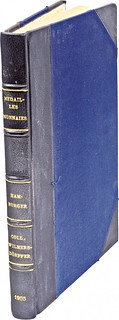 From 7 to 9 December 2021, the Osnabrück auction house Künker offers in its eLive
Premium Auction 357 almost 2,000 lots with historical fixed-price lists and auction catalogs
from the Alain Poinsignon Library. Many collectors around the world are familiar with the
Strasbourg coin dealer. He opened his first coin shop in 1974 in Mulhouse. In 1984 he moved
to Strasbourg, where he ran the
From 7 to 9 December 2021, the Osnabrück auction house Künker offers in its eLive
Premium Auction 357 almost 2,000 lots with historical fixed-price lists and auction catalogs
from the Alain Poinsignon Library. Many collectors around the world are familiar with the
Strasbourg coin dealer. He opened his first coin shop in 1974 in Mulhouse. In 1984 he moved
to Strasbourg, where he ran the Poinsignon Numismatique
shop for many decades. Alain
Poinsignon took pride in the excellent quality of his coin identifications, for which he
compiled an extensive library. With about 8,000 books, magazines and 3,000 auction
catalogs, his numismatic library is probably one of the most important specialist libraries of
Europe in private hands.
With meticulousness, knowledge and passion, Alain Poinsignon collected the historical auction catalogs of the 19th and early 20th century that are of essential importance to any coin dealer who cares about the provenance of special items. A bibliophile delight awaits the bidder. Alain Poinsignon himself was a bibliophile in the best sense and attached particular importance to neat bindings.
JOSEPH HAMBURGER, Auction [1] of 16 October 1905, Frankfurt am Main. Max Ritter von Wilmerdörffer'sche Münzen und Medaillen-Sammlung. Erste Serie: Kunstmedaillen der Renaissance, Münzen und Medaillen der Schweiz, Frankreich, Elsass und Lothringne, Baden, Württemberg, Hohenzollern. Poinsignon half leather binding. Dedication copy printed on extra fine paper.
A Glance at the History of the International Coin Trade
Auction catalogs and fixed-price lists are the best source for reconstructing the history of the
coin trade. Therefore, it is absolutely justified that these works became collectibles over the
past two decades. They tell us about the men and women who supplied collectors all over the
world with coins for many centuries.
At this point we would like to present just one example. It represents numerous coin dealers and collectors whose past is documented by the works that are part of the Poinsignon Library. Lot No. 3566 takes us to Frankfurt, where Leo Hamburger, founder of the then most important coin dealership in Germany, had died on 12 February 1902. The Name L. & L. Hamburger stood for him and his cousin of the same name, who had helped him build up the business as his partner for almost 30 years. But Leo Hamburger had a son. Although Joseph had learned the trade in his father's coin shop for a few, short years, he had preferred to go abroad to make his fortune. He did not succeeded in doing so. Therefore, he travelled back home to claim his share of the inheritance as soon as he heard of his father's death. Naturally, a dispute arose between him and Leo Hamburger the younger. The dispute was only settled more than a year later. Joseph Hamburger got his father's house, which had housed the L. & L. Hamburger coin shop until then. Leo Hamburger the younger took over the company including all assets and liabilities. However, he had to move and establish his company at a new address. At that time, both – Leo Hamburger and Joseph Hamburger – competed for the old customers of the late company founder.
Joseph Hamburger achieved a coup in this process, as is evidenced by his first auction catalog: he succeeded in convincing friends of his family to auction off their extensive collection with him immediately after founding the new company. Max Ritter von Wilmersdörffer, who died in 1903, had been apprenticed to Josef Nathan Oberndörffer in Munich together with Joseph's father Leo Hamburger. In addition to his bank, Oberndörffer operated an international coin dealership in Ansbach, Munich, Vienna and Paris. Thus, Wilmersdörffer trained as both banker and numismatist, and when he married Oberndörffer's only daughter, he became his heir. After Oberndörffer's death, Wilmersdörffer became head of the bank while the coin trade was still operated by Abraham Merzbacher, who had married a niece of Oberndörffer. In 1873, the bank cut ties with its numismatic department, which developed into the Munich coin shop Merzbacher. But Wilmersdörffer had obviously caught the numismatic virus. He became one of the most important coin collectors in Bavaria and a founding member of the Bavarian Numismatic Society.
Collectors, Collectors, Collectors
That is a lot of history for little money, isn't it? If you cannot afford medallions from the
Gnecchi Collection, aurei from the Montagu Collection, Greek coins from the Caruso
Collection or unique rarities from the collection of the Egyptian King Farouk, the auction
catalogs that offered these collections are a true alternative. You can find the catalogs of all
your favorite provenances in the Poinsignon Library at Künker.
All lots have a starting price of 10 euros, which is why every bibliophile has a chance to get their hands on one of the almost 2,000 lots.
You can find the eLive Premium Auction online at www.eLive-Auction.de. To order a catalog contact Künker, Nobbenburger Straße 4a, 49076 Osnabrück; phone: +49 541 962020, fax: +49 541 9620222; or via e-mail: service@kuenker.de. Please remember to register for the online auction in good time if you don't have your myKuenker account yet.
ANS ANNOUNCES PRINT-ON-DEMAND PROGRAM
In a November 24, 2021 email to its membership, the American Numismatic Society announced a new print-on-demand program for numismatic literature. -Editor
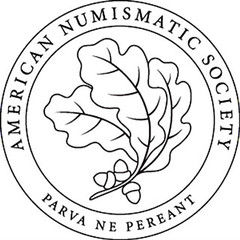 Every month the ANS will release 4–10 out-of-print and new titles as official POD editions, from recent monographs to the earliest numbers from series such as Numismatic Studies and Numismatic Notes and Monographs.
Every month the ANS will release 4–10 out-of-print and new titles as official POD editions, from recent monographs to the earliest numbers from series such as Numismatic Studies and Numismatic Notes and Monographs.
Why print-on-demand?
Many popular ANS titles are now out-of-print. POD rescues these and offers affordable, high-quality editions using the original design and images from the first printing.
Our print-on-demand books and journal issues are officially branded by the ANS at prices often significantly lower than the resale market.
On occasion, new ANS books will be published directly as POD saving readers time and money in receiving new volumes.
How does it work?
Visit the ANS Store and search/filter for POD
or Print on Demand
. Click the Add to Cart
button and proceed to check-out. The ANS Member discount of 30% applies to POD books just like it does for new titles. Because of supply chain issues affecting the availability of paper, books will ship directly to you from the printer in approximately 2–3 weeks once your order is received.
Two new titles (described in the next two articles in this issue) are available through the new print-on-demand program. -Editor
To visit the ANS Store, see:
http://numismatics.org/store/
NEW BOOK: COMMEMORATIONS OF WASHINGTON
The late Syd Martin was not only a Board Member of the Numismatic Bibliomania Society and author of multiple award-winning landmark books on U.S. colonial numismatics, he was also an avid collector and student of numismatic souvenirs of the 1932 bicentennial of George Washington's birth. He tracked these items relentlessly, scouring flea markets and online listings alike with the same gusto he held for locating rare varieties and previously unpublished information about colonial coinage. Like all his other books, Syd's catalog is long-awaited and sure to become the standard reference for the field. -Editor
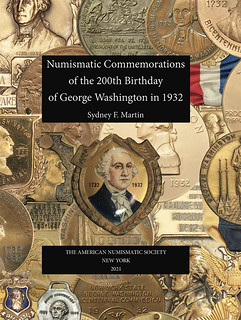 Numismatic Commemorations of the 200th Birthday of George Washington in 1932
Numismatic Commemorations of the 200th Birthday of George Washington in 1932
by Sydney F. Martin
Hardcover ISBN 978-0-89722-371-3
Paperback ISBN 978-0-89722-378-2
600 pp., full-color figs. throughout
HARDCOVER
Retail Price: $150 + s/h
Member Price: $105 +s/h
PAPERBACK
Retail Price: $100 + s/h
Member Price: $70 +s/h
The celebration of the bicentennial of the birth of George Washington in 1932 is perhaps the largest public demonstration of singularity of purpose the world has ever seen. Beginning in 1924 with the establishment of a National Committee chaired by the President of the United States and culminating with an incredible level of activity during 1932, it stands as a testimonial to our Founding Father. Representing a lifetime of collecting numismatic monuments to Washington, Martin's book serves as a guide to the richness of 1932's output, documenting hundreds of examples from across the United States. The book is divided into six chapters: Background and Purpose; Coins, Medals, Tokens, and Badges; Lapel Pins, Buttons, and Brooches; Ribbon-Badges; Plaques; and Die-Stamped and Cast Novelties. Appendixes of manufacturers and acronyms, bibliography, and general index follow.
ABOUT THE AUTHOR
Sydney F. Martin (1945–2021) was a Life Member of the Colonial Coin Collectors Club (C4), and for 10+ years was the editor of its award-winning quarterly C4 Newsletter. He was a life member, Fellow, and Past President of the American Numismatic Society (ANS).
To watch Syd Martin's 2020 Huntington Award lecture on the topic, see:
2020 Huntington Award to Sydney Martin, "Commemoratives of the 200th Birthday of George Washington"
(https://www.youtube.com/watch?v=yafx3CBv3QU)
For more information, or to order, see:
Numismatic Commemorations of the 200th Birthday of George Washington in 1932
(http://numismatics.org/store/martin/)
NEW BOOK: FAUSTINA THE YOUNGER
The second new ANS book is Martin Beckmann's work on the coinage of Faustina the Younger. -Editor
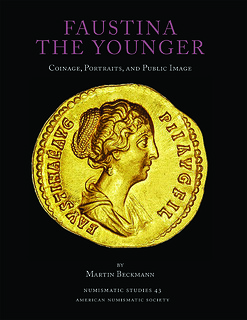 Faustina the Younger
Faustina the Younger
(Numismatic Studies 43)
by Martin Beckmann
Retail price: $70 plus shipping & handling
ANS Member price: $49 plus shipping & handling
ISSN 0517-404X
Hardcover ISBN 978-0-89722-366-9
vii + 175 text pages, color and b/w figs., 30 color plates
The Roman empress Faustina the Younger, wife of the emperor Marcus Aurelius and mother to at least eleven imperial children, including the future emperor Commodus, not only played a key role in Roman history of the 2nd century AD but also was the subject of almost unparalleled commemoration in visual media, especially sculpture and coinage, during her lifetime. This book examines the single largest surviving ancient source for the portraiture and public image of Faustina the Younger: the coinage struck in her name under Antoninus Pius and Marcus Aurelius.
The coinage of Faustina the Younger is rich in original iconography and long in duration but its chronology and the relationships between its various types are unclear at best, unknown at worst. This study seeks to remedy this situation by employing the methodology of die analysis to create a new and firm chronology for Faustina's coinage. The results make it possible to establish an authoritative typology for Faustina's portraiture and to show the precise relationship between the diverse obverse and reverse types. The die analysis also clarifies Faustina's complicated iconographic program, making it possible to compare it directly with the iconography of the better-dated coinage of her male contemporaries. Taken together, these results permit a complete re-evaluation of the coinage, portraits and public image of Faustina the Younger.
ABOUT THE AUTHOR
Martin Beckmann is Associate Professor in the Department of Classics at McMaster University. He is the author of DIVA FAVSTINA: Coinage and Cult in Rome and the Provinces and The Column of Marcus Aurelius: The Genesis and Meaning of a Roman Imperial Monument.
For more information, or to order, see:
Faustina the Younger
(http://numismatics.org/store/faustinayounger/)
NEW BOOK: THE WINCHESTER MINT REPRINT
Ted Banning passed along this news of a coming reprint of the 2012 Martin Biddle catalogue of the known coins of the Winchester Mint. Thanks. -Editor
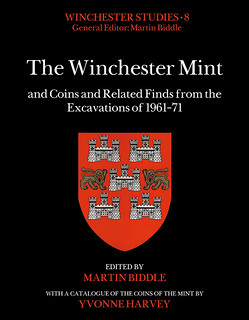 FORTHCOMING (REPRINT AND OPEN ACCESS)
FORTHCOMING (REPRINT AND OPEN ACCESS)
The Winchester Mint and Coins and Related Finds from the Excavations of 1961–71
edited by Martin Biddle. Hardback; 215x276mm; 768pp. Print RRP: £115.00 (eBook to be Open Access). 781 2021 Winchester Studies 8. ISBN 9781803270128.
Winchester Studies 8: Edited by Martin Biddle with a catalogue of the known coins of the mint by Yvonne Harvey, this volume records and illustrates the minting of silver pennies in Winchester between the reigns of Alfred the Great and Henry III, a period of three and a half centuries. At the Mint, which was situated in the area of the High Street to the east of where the city's cross now stands, at least 24 million silver pennies (possibly as many as 50 million) were struck. Five and a half thousand survive in museums and collections all over the world. These have been sought out and photographed (some 3200 coins in 6400 images detailing both sides), and minutely catalogued by Yvonne Harvey for this volume.
During the period from late in the reign of Alfred to the time of Henry III, dies for striking the coins were produced centrally under royal authority in the most sophisticated system of monetary control at the time in the western world. In this first account of a major English mint to have been made in forty years, a team of leading authorities have studied and analysed the use the Winchester moneyers made of the dies, and together with the size, weight, and the surviving number of coins from each pair of dies, have produced a detailed account of the varying fortunes of the mint over this period. Their results are critical for the economic history of England and the changing status of Winchester over this long period, and provide the richest available source for the history of the name of the city and the personal names of its citizens in the later Anglo-Saxon period.
This is a reprint of the volume originally published in 2012 (Oxford, ISBN 9780198131724).
Reviews of the 2012 edition:
It is a pleasure to give a very warm welcome to this mighty and long-awaited volume which sets out in meticulous detail what is currently known about the output and operations of the Winchester mint between Edgar's reform of the coinage in c.973 and the mint's final closure early in 1250.
…Martin Biddle, the presiding genius of the Winchester excavations and the instigator of the Winchester Studies series… and Yvonne Harvey can properly pride themselves on a monumental task now happily accomplished.
– Hugh Pagan, Numismatic Circular (October 2012) ;
… At its heart is a dazzling detailed corpus of coins struck in Winchester between the reigns of Alfred and Henry III. This is as near comprehensive as possible … and the scale of her [Yvonne Harvey] efforts in its production are staggering, with tens of thousands of comparisons needed to complete the die study alone. Students of Late Saxon coinage should be grateful to her for producing such a tremendous resource and it will be a fitting legacy that her work is likely to act as the foundation and inspiration for a whole new generation of scholars.
… It is an exemplary record of the numismatic material from the excavations with a detailed catalogue and discussion of how coins were made in the town. … The book will continue to be important and relevant as a foundation for much further work for many years to come. Any collector or scholar of the period should have a copy on their shelf.
– Andrew Woods, Curator of Numismatics at the Yorkshire Museum's Trust
To read the complete article, see:
FORTHCOMING (REPRINT AND OPEN ACCESS): The Winchester Mint and Coins and Related Finds from the Excavations of 1961–71
(https://archaeopress.com/ArchaeopressShop/Public/displayProductDetail.asp?id=%7B622FC9D8-81C9-4CFA-B82C-653D0865F76A%7D)
To read the earlier E-Sylum article, see:
NEW BOOK: THE WINCHESTER MINT
(https://www.coinbooks.org/esylum_v15n19a04.html)
ONLINE RESOURCES FOR ANCIENT COINS
The latest article in the CoinWeek Ancient Coin Series by Mike Markowitz discusses several online resources for researching ancient coins. These are all great picks, and many are useful for other numismatic specialties as well. We've covered many of these before in The E-Sylum, but this is a great one-stop reference. Here's an excerpt - be sure to read (and bookmark) the complete article online. -Editor
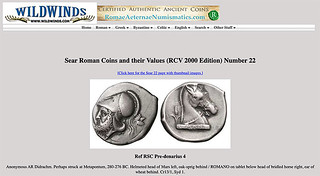 For many collectors of classic and modern American coins, the only information resource they need is the old, reliable
For many collectors of classic and modern American coins, the only information resource they need is the old, reliable Red Book
, which will mark its 75th anniversary in 2022.
Collectors of ancient coins, however, face a problem that is considerably more complex. With thousands of types issued by hundreds of cities, states, and rulers over many centuries, information on ancient coins is scattered across out-of-print books and obscure journal articles in many languages. A common saying among old-school collectors is buy the book before you buy the coin
– but finding these books often requires diligent, patient search, and buying them may demand deep pockets.
Fortunately, during the past two decades, a tremendous range of instantly accessible online resources has emerged to help the collector of ancient coins in their study and research.
The following is a personal listing of high-quality websites that I have found useful in my own research and study.
Coin Archives
Launched in October 2002 by A.J. Gatlin, a collector, talented web developer, and database programmer, CoinArchives.com is a repository for coin auction catalogs in the digital domain. Its goal is to make entire auction catalogs … available to Internet users for both academic and commercial research.
The free website provides listings (without prices realized) for the most recent six months. The subscription service, Pro CoinArchives, provides listings back to the beginning of this century with prices realized. This is a relatively expensive subscription service ($600 per year), intended mainly for dealers and high-end collectors, but there is an academic discount (without the prices realized) priced according to the number of accounts requested per institution.
Wildwinds
Supported in part by advertising, WildWinds is well-maintained. The website lists over 76,000 coin types, including Greek, Roman, Byzantine, Celtic, and English hammered. Greek coins can be searched by cities, geographic regions, rulers, tribes, etc. Roman coins can be searched by ruler (or gens – the extended family or clan
of officials responsible for coinage, a traditional way of referencing Republican coins), or by catalog number in the first three volumes of David Sear's monumental five-volume reference, Roman Coins and Their Values. Byzantine coins are searchable by ruler, or by catalog number in Sear's Byzantine Coins and Their Values (1987). In some cases, the text provides prices realized and pedigree information for a coin, but this is not consistent.
To read the complete article, see:
Online Resources for Researching Ancient Coins
(https://coinweek.com/ancient-coins/online-resources-for-researching-ancient-coins/)
WERNER BURGER (1936-2021)
In her latest Chinese Money Matters blog, Helen Wang of the British Museum published an obituary of Hong Kong numismatist Dr. Werner Burger. -Editor
Werner Burger (Chinese: 布威纳 Bu Weina) was born in Munich in 1936. He studied Chinese at Ludwig Maximilian University of Munich (LMU), graduating in 1962, with a thesis on Chinese money. According to an announcement by the Chinese Numismatic Museum in Beijing, Burger took 16 years to complete his PhD (instead of the usual 3-4 years), and 30 years to complete his volume Ch'ing Cash (2016).
In 1963 he went to China to teach German in Shanghai. When the school he was teaching at closed down, he was sent to be a sheep farmer. He moved to Hong Kong in 1965.
Burger was also a member of the major research project Monies, Markets and Finance in China and East Asia, 1600-1900: Local, Regional, National and International Dimensions led by Hans Ulrich Vogel in Tübingen. For this project, he was looking in particular at "Qing Coinage, 1850-1911: Mint Statistics, Numismatic Evidence, and Monetary Policy".
Burger's publications include the following titles:
-
Manchu Inscriptions on Chinese Cash Coins
, in American Numismatic Society Museum Notes XI (1964) -
Um Amuleto em Manchu
, in Boletim do Instituto Luís de Camµes (1969) -
Minting during the Qianlong Period: Comparing the Actual Coins with the Mint Reports
, in Christine Moll-Murata, Song Jianze and Hans Ulrich Vogel (eds.), Chinese Handicraft Regulations of the Qing Dynasty (2005) - Chinese section of Coins of the World 1750-1850, by W.D. Craig (1976)
- Ch'ing cash until 1735, Mei Ya Publications, Taipei, 1976
- Ch'ing Cash, University Museum and Art Gallery, The University of Hong Kong, 2016.
To read the complete article, see:
WERNER BURGER (1936-2021)
(https://chinesemoneymatters.wordpress.com/2021/11/26/werner-burger-1936-2021/)
CHARLES BARBER LETTER ON ANTHONY PAQUET DIES
A recent addition to the Newman Numismatic Portal is a letter from Charles Barber letter about Anthony Paquet coin dies. Project Coordinator Len Augsburger provided the following report. Thanks. -Editor
Anthony Paquet Dies
Anthony C. Paquet was Assistant Engraver of the U.S. Mint from 1857 to 1864 and engraved approximately 30 medals in the U.S. Mint medal series (catalogued by Julian), in addition to working on federal coinage. Paquet's 1861 $20 double eagle is a legendary U.S. rarity, with an example recently sold by Heritage at this year's ANA Convention for $7.2 million.
The Paquet family evidently left certain dies behind, and Charles Barber wrote to Philadelphia Mint Superintendent A. Loudon Snowden on August 27, 1883, I have examined the dies left here by the Paquet family, and respectfully report that I consider them valueless. In the case of the Trade Dollar, we have the hubs made from these dies. Therefore can make any number required. The others are old experimental dies and therefore of no value now.
Whether the old experimental dies
included the famous tall letters
1861 $20 reverse die is a matter for conjecture, but what is certain is that today's collectors would place for more value on the Paquet dies than did the engraver Charles Barber.
Image: 1861 $20 Pacquet MS67 PCGS CAC, ex. Heritage Auctions ANA 8/2020, lot 3471, realized $7.2 million, images courtesy of Heritage Auctions.
Link to Charles Barber letter on Newman Portal:
https://archive.org/details/paquetdiesarevalueless18830827/page/n1/mode/2up
NNP SEEKS LIBRARY TECHNICAL ASSISTANT
Newman Numismatic Portal Project Coordinator Len Augsburger provided this announcement of an job opening. -Editor
Newman Portal is seeking a full-time library technical assistant to help continue the growth of this online resource. This position is based at Washington University in St. Louis, with duties as follows:
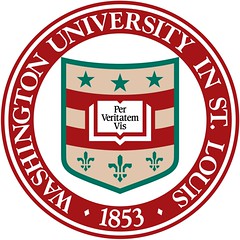
Manages the digital imaging of numismatic materials including shipping, receiving, image capture, image processing, metadata creation, and ingesting of digital content into the Internet Archive. Oversees student workers employed by the Newman project including hiring, training, scheduling and quality control of work. Creates and maintains documentation for digitization processes and the progress of digitization operations. Maintains digitization equipment and software, including image capture and image processing software. Regularly reviews and updates current digital imaging standards and workflows. Participates in library-wide and university-wide activities, committees, special projects and programs, as assigned.
Link to Washington University job posting:
https://wustl.wd1.myworkdayjobs.com/en-US/External/job/Washington-University-West-Campus-Clayton-Missouri/Library-Technical-Assistant--Time-Limited----Digitization_JR63359
As noted earlier, many numismatic organizations are hiring these days, in various disciplines. -Editor
To read the earlier E-Sylum articles, see:
STACK'S BOWERS GALLERIES IS HIRING
(https://www.coinbooks.org/v24/esylum_v24n45a16.html)
WHITMAN PUBLISHING SEEKS ASSOCIATE EDITOR
(https://www.coinbooks.org/v24/esylum_v24n46a18.html)
PRINCETON SEEKS BYZANTINE CATALOGUER
(https://www.coinbooks.org/v24/esylum_v24n47a14.html)
MORE ON HOLLAND WALLACE
Dave Lange submitted these notes on Holland Wallace. Thanks! -Editor
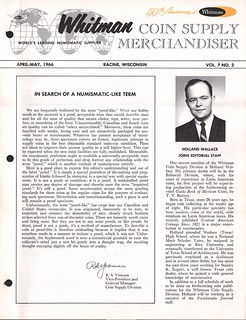 I noticed that the numismatic library of Holland Wallace is coming up for sale. That's a name that became familiar to me while researching and writing my book on Whitman products.
I noticed that the numismatic library of Holland Wallace is coming up for sale. That's a name that became familiar to me while researching and writing my book on Whitman products.
Wallace joined the company in 1966 and was with it for several years. He was a specialist in the numismatics of Latin America and contributed to both Whitman's world books and its monthly periodical, The Whitman Numismatic Journal. I see from the auction catalog that he also published his own lists of world coins starting 1976. Ken Bressett undoubtedly could tell readers much more.
I'm attaching the front page of the April-May 1966 issue of Whitman Coin Supply Merchandiser, a publication for the company's jobbers and coin dealers. I used this periodical extensively in researching my book, and it includes an announcement of Holland's hiring.
The article has some nice biographical information in addition to the great photo. The cover also includes a nice article by R. S. Yeoman lamenting the rise of the term "proof-like". Click on the image to see a higher resolution version on our Flickr archive. -Editor
To read the earlier E-Sylum article, see:
WORKMAN BOOKS DECEMBER 15, 2021 SALE
(https://www.coinbooks.org/v24/esylum_v24n47a03.html)
NOTES FROM E-SYLUM READERS: NOVEMBER 28, 2021
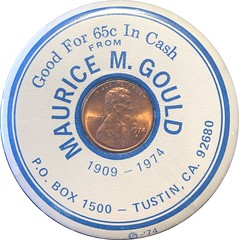 Collecting Numismatic Advertising Mirrors
Collecting Numismatic Advertising Mirrors
Cole Hendrickson writes:
"Regarding Pete Smith's article in the recent E-Sylum, I thought I would chime in to say that he is not the only person interested in numismatic advertising mirrors! While I don't quite have a collection of them, I do have one example which is a Maurice M. Gould advertising mirror with an encased 1974-D cent. As Pete mentioned in the article, they are an interesting area of numismatic history that brings to light numismatic individuals who might otherwise be forgotten."
Thanks! Glad to hear it! Interesting piece - kind of a combination mirror / encased cent. Nice. -Editor
Pete Smith adds:
"The Gould mirror is also a "Good For" trade mirror. That gives it a link to trade mirrors from the 1890's."
To read the earlier E-Sylum article, see:
ROBERT ARTHUR JOSLIN, SR. (1935-2005)
(https://www.coinbooks.org/v24/esylum_v24n47a16.html)
On The World's Oldest Mint
Ted Puls writes:
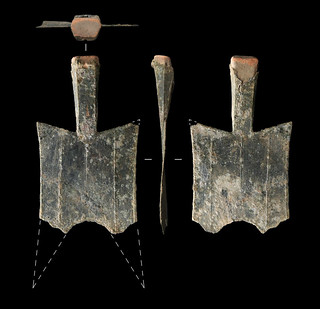 "The nice reference to the
"The nice reference to the oldest mint
(I think this in the second or third bit about this in The E-Sylum) was fun but the photo of a coin mold had nothing to do with the article. The coin mold shown was labeled as being from the Eastern Han dynasty, which wasn't clear from the photo but the Wu Zhu were not even invented until 119B.C. 300 years after the closing of the mint. The Eastern Han didn't start for hundreds of years after the era of the mint described.
I find it humorous when cast Chinese coins are described as struck
as in this article. Also the bone cowrie money shown in the referenced article, wasn't struck but carved supposedly from deer bone, and without archeologic evidence, only opinion, suspect that this type may have been made during the Xin
dynasty revival of ancient forms between the Western and Eastern Han."
Thanks. Sometimes images are added by people other than the authors. I do it often to provide some visual spice to an article. But that coin mold image was in the original piece. I don't see it in the earlier articles we published or referenced. Above is an image from our original article. -Editor
To read the earlier E-Sylum articles, see:
'WORLD'S OLDEST' COIN FACTORY FOUND
(https://www.coinbooks.org/v24/esylum_v24n32a27.html)
LOOSE CHANGE: NOVEMBER 21, 2021 : Ancient Chinese Coins and the World's Oldest Mint
(https://www.coinbooks.org/v24/esylum_v24n47a30.html)
More on Miquel Pratt
 Reader Steve writes:
Reader Steve writes:
"In the recent E-Sylum announcement of Raúl Olazar's Paraguay book he mentions in the dedication Miquel Pratt - who I did not know passed away. As I wrote to his daughter Arami.... Miquel was an outstanding person who I remember fondly from his days at MTB (as my office was next to Rockefeller Center) and from all subsequent Coin Shows the World Over, be it here in the US or in Hong Kong etc. He was always so pleasant. Sincere condolences."
"He was ultimately responsible for bringing Paraguay collecting to the outside world. He would frequently bring me numismatic related items, like coin decorated gaucho belts or this long (15") silver poncho pin with a coin and figurine attached etc."
Thanks. Steve included a picture and mention of Miquel in his earlier 9/11 submission. -Editor
To read the earlier E-Sylum articles, see:
THOUGHTS ON THE ANNIVERSARY OF 9/11
(https://www.coinbooks.org/v24/esylum_v24n37a16.html)
NEW BOOK: HISTORIA DE LA MONEDA EN PARAGUAY
(https://www.coinbooks.org/v24/esylum_v24n46a02.html)
Another Coin Collector Figurine
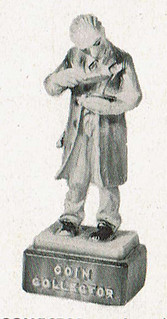 Bob Van Ryzin writes:
Bob Van Ryzin writes:
"Noticed an ad for a standing coin collector in the August 1963 issue of Coins magazine, while working on my column for Numismatic News. The figure sold for $2.95, was hand painted and stood 7 inches high. It, like a stamp collector version, was "for the collector who has most everything." Though the ad image is poor, it appears to show the coin collector examining a coin or medal, using a magnifying glass. The base reads "Coin Collector," in case you couldn't tell what the long-coated gentleman was doing."
Thanks! -Editor
To read the earlier E-Sylum articles, see:
NOTES FROM E-SYLUM READERS: OCTOBER 31, 2021 : Another Porcelain Coin Collector
(https://www.coinbooks.org/v24/esylum_v24n44a08.html)
NOTES FROM E-SYLUM READERS: OCTOBER 17, 2021 : The Goebel Coin Collector
(https://www.coinbooks.org/v24/esylum_v24n42a09.html)
DNW OCTOBER 2021 NUMISMATIC LITERATURE : Lot 1576: Porcelain Coin Collector Figure
(https://www.coinbooks.org/v24/esylum_v24n41a02.html)
Rembrandt Etching: The Gold Weigher
Nick Graver passed along this Heritage lot of a 1639 Rembrandt Etching called "The Gold Weigher". Thanks. -Editor
To read the complete lot description, see:
Rembrandt van Rijn (Dutch, 1606-1669). Jan Uytenbogaert (The Gold Weigher), 1639. Etching and drypoint...
(https://fineart.ha.com/itm/prints-and-multiples/rembrandt-van-rijn-dutch-1606-1669-jan-uytenbogaert-the-gold-weigher-1639etching-and-drypoint/a/13177-28138.s)
Global Certification Services Sample Slab
Kellen Hoard writes:
"I was interested to see the discussion of Global holders in recent E-Sylums because the service made a few sample slabs in their time. I only own one as they are rather rare. You'll notice that its label as a sample is relatively hard to spot; at the bottom of the reverse, right side of the slab it is marked SAMPLE.
"
Interesting - thanks. -Editor
To read the earlier E-Sylum articles, see:
QUERY: GLOBAL CERTIFICATION SERVICES
(https://www.coinbooks.org/v24/esylum_v24n46a13.html)
NOTES FROM E-SYLUM READERS: NOVEMBER 21, 2021 : Story Vaults
(https://www.coinbooks.org/v24/esylum_v24n47a10.html)
WAYNE'S NUMISMATIC DIARY: NOVEMBER 21, 2021 : Daniel Frank Sedwick
(https://www.coinbooks.org/v24/esylum_v24n47a24.html)
ANS 2022 NUMISMATIC CONGRESS TRAVEL GRANTS
The American Numismatic Society is making available travel grants to the 2022 International Numismatic Conference in Warsaw. -Editor
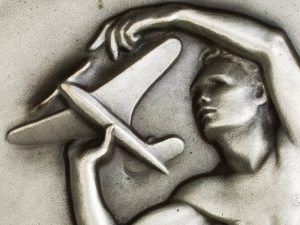 The American Numismatic Society (ANS) announces that it will make travel grants available for attendees of the XVIth International Numismatic Congress who would be unable to attend otherwise. The ANS will award these grants to up to eight eligible applicants.
The American Numismatic Society (ANS) announces that it will make travel grants available for attendees of the XVIth International Numismatic Congress who would be unable to attend otherwise. The ANS will award these grants to up to eight eligible applicants.
The International Numismatic Congress is convened every six years as a regular assembly of numismatic scholars, curators, and researchers and consists of paper and poster presentations, panels, and updates on the most current research in the field of numismatics. The XVIth Congress will be held September 11-16, 2022 in Warsaw, Poland. More information about the Congress can be found at https://inc2022.pl/.
Each awardee of an ANS travel grant will receive up to $750 to be used towards the cost of travel to and from Warsaw. In order to be eligible for the grants, applicants must be members of the American Numismatic Society in good standing.
To be considered for a grant, applicants must complete an application form found at the link here. The application consists of a resume and a single page letter detailing the applicant's relationship to the field of numismatics, relevant academic or publication credentials, reasons for attending the Congress, and any current financial need. Applicants are not expected to present a paper or poster at the Congress, but those who expect to present a paper or poster should note this in their application letter.
Applicants should submit their complete application materials by March 15, 2022.
To read the complete article, see:
American Numismatic Society Sponsors Travel Grants for the International Numismatic Congress in Warsaw
(http://numismatics.org/warsaw-travelgrants/)
STACK'S BOWERS PHILADELPHIA GALLERY OPENS
Stack's Bowers Galleries has opened their new location in Philadelphia. Here's their blog post. -Editor
Three weeks ago, we shared in a blog that we were nearing the completion date of our newest storefront office, this one in downtown Philadelphia. Since that blog was posted, we have completed our soft opening of the storefront and we are now accepting business. We are located at 1735 Market Street, at the corner of 18th Street and JFK Boulevard. ?
This Philadelphia gallery offers the firm's entire range of services covering all manner of numismatics. Collectors can sell their coins and paper money for top market value and browse an extensive selection for direct purchase. The gallery serves as an important resource for gold and silver bullion trading, appraisals, and auction expertise.
The Philadelphia gallery will be led by Head Numismatic Trader Robert Avena, one of the industry's most respected experts. Mr. Avena has been part of the Stack's Bowers Galleries team since 2000 and is a life member of the American Numismatic Association (ANA), the Silver Dollar Round Table, and the Florida United Numismatics (FUN). Joining him is store manager, Mark Curcio, a life-long collector and dealer with over 35 years of experience encompassing the full spectrum of numismatics, from Ancient coins through modern world currency.
We invite you to pay us a visit at our newest location the next time you are in Philadelphia.
I understand that on display at the new location is a 100+ ounce Justh & Hunter gold bar recovered from the S.S. Central America shipwreck. -Editor
To read the complete article, see:
The Stack's Bowers Galleries Philadelphia Location Open for Business
(https://www.stacksbowers.com/News/Pages/Blogs.aspx?ArticleID=stacks-bowers-galleries-opens-in-downtown-philadelphia)
To read the earlier E-Sylum article, see:
STACK'S BOWERS OPENS PHILADELPHIA GALLERY
(https://www.coinbooks.org/v24/esylum_v24n09a24.html)
VOCABULARY TERM: GERMAN-SILVER
This week's entry from Dick Johnson's Encyclopedia of Coin and Medal Terminology is a short one on German-silver. -Editor
German-silver. A copper alloy of silver-white color because of the presence of nickel and zinc, now called nickel-silver. There is no silver in German-silver or nickel-silver. The most common formula for German-silver is 55 copper, 25 zinc, 20 nickel; the best is 46 copper, 34 zinc, 20 nickel. But the range of alloys described as German-silver is broad: 50 to 62 copper, 20 to 30 zinc, 15 to 30 nickel. In Western countries the name was dropped during World War I (for anti-German sentiment) in preference to nickel-silver.
German-silver is ideal for striking and makes a hard alloy, particular for badges, charms, keytags and items to be worn. Despite its color it is not a white metal (because of its hardness). See composition.
To read the complete entry on the Newman Numismatic Portal, see:
German-silver
(https://nnp.wustl.edu/library/dictionarydetail/515988)
The NNP Dictionary also includes this entry on the topic from Breen's Encyclopedia. -Editor
German silver
Dr. Lewis Feuchtwanger's term (ca. 1837-64) for any of several white alloys of copper, nickel, tin, zinc, antimony, etc. His other term "American silver" quickly became obsolete; "Feuchtwanger's metal" refers to the alloy he used for his sample coins. Other alloys in the same family are known as argentan, argenton, britannia, maillechort, packtong, etc. None contain any silver. NUM 6/13, pp. 297-302.
To read the complete entry on the Newman Numismatic Portal, see:
German silver
(https://nnp.wustl.edu/library/dictionarydetail/514277)
ROBERT LYNN HENDERSHOTT (1898-2005)
American Numismatic Biographies author Pete Smith submitted this article on Bob Hendershott. Thanks! -Editor
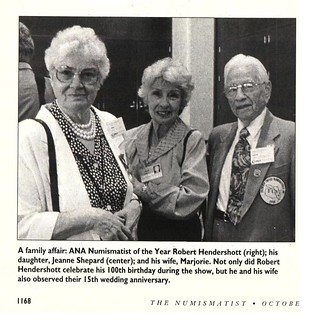 Robert Hendershott was born in the nineteenth century and died in the twenty-first century. His
birth was in St. Louis on August 7, 1898. His parents were Chalmers Doran Hendershott and
Cordelia Bartlett Hendershott. Intending a career in banking, he attended Washington University
in St. Louis and the Glen City Business College at Quincy, Illinois.
Robert Hendershott was born in the nineteenth century and died in the twenty-first century. His
birth was in St. Louis on August 7, 1898. His parents were Chalmers Doran Hendershott and
Cordelia Bartlett Hendershott. Intending a career in banking, he attended Washington University
in St. Louis and the Glen City Business College at Quincy, Illinois.
Robert married Marguerite Hamilton on June 6, 1922, and had a daughter, Jeanne. His first wife died on February 18, 1981. His second marriage was to Marjorie Owen in 1983.
Marjorie was born as Marjorie Holmes in 1924. She married Lowell Owen in 1941 and had four children. Lowell died in 1976 and she remarried Robert L. Hendershott in 1983. She served as the first woman president of the Central States Numismatic Society for 1990-1992. Marjorie outlived Robert and died in 2013. As a six-year-old child, he walked with his father to the 1904 Louisiana Purchase Exposition and World's Fair. Some time later he wrote the book on 1904 St. Louis World's Fair Mementos and Memorabilia published in 1994.
His first job prior to college was a bank janitor. He was promoted to bank clerk for the Bank of Hawk Point at Lincoln, Missouri. Once out of college, he worked for a bank in Macomb, Illinois. He moved to Florida and briefly sold real estate before joining The Exchange National Bank in Tampa. He bought the bankrupt Mirasol Hotel on Davis Island and made it profitable. With that success he expanded to buy up several other hotels in the area. He became president of the Sarasota hotel owner's association. He was Director of the Clearwater Chamber of Commerce convention bureau, retiring in 1975.
He was founder of the Tampa Coin Club. He was also founding member of Florida United
Numismatists (FUN) in 1955, served as first president and as general chairman for the club's
shows for decades. He wore an orange jacket and was known as Mr. FUN.
Also he was
convention chairman for the successful 1974 ANA convention in Bal Harbor, Florida.
Robert received an ANA Medal of Merit in 1986 and the Farran Zerbe Memorial Award in 1993. This was followed by a lesser award, the Glenn Smedley Memorial Award in 1995, a Lifetime Achievement Award in 1997 and Numismatist of the Year in 1998. He was inducted into the ANA Numismatic Hall of Fame in 2000.
Hendershott celebrated his 100th birthday during the 1998 ANA convention in Portland, Oregon.
He signed and passed out Round TUIT's
to convention visitors.
Robert died in Des Moines, Iowa, on March 23, 2005, after a life span of 106 years, seven months and fourteen days. By comparison, Eric P. Newman, also born in St. Louis, lived for 106 years, five months and twenty-one days.
His name was listed as R. L Hendershot when he joined the ANA in 1931 as member 3867, making him a member for 74 years. Eric P. Newman joined in 1935 as member 4624 and was a member for 82 years. Smarty-Pants question of the week: Who was the ANA member for the longest period of time? Bonus question: Who will be the topic for my next article?
Bob Hendershott's Birthday Wooden Nickel
"I also have a Round TUIT signed by Robert Hendersott on August 7, 1998. What last week's article failed to mention was that it was signed on Hendershott's one hundredth birthday.
I recall that NBS president Michael Sullivan called for a breakfast meeting of the board at the hotel during the 1998 ANA convention. Robert and Marjorie Hendershott came into the restaurant and I was able to wish him a happy birthday that morning."
Great story! It may have been the 1996 Denver convention when I shared a Colorado Springs tour with Bob. He was quite spry for his age, walking up and down every flight of steps with the rest of us as we took in sights around town. Nice guy. -Editor
To read the earlier E-Sylum article, see:
WAYNE'S NUMISMATIC DIARY: NOVEMBER 21, 2021 : Bob Hendershott's Wooden Nickel
(https://www.coinbooks.org/v24/esylum_v24n47a24.html)
WILLIAM WELLS BROWN, WILDCAT BANKER?
An article by Ross Bullen in the Public Domain Review chronicles the life of William Wells Brown and his experience issuing scrip notes in the wildcat banking era. -Editor
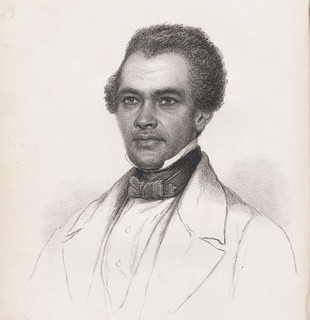 On January 1, 1834, a young man named William escaped from slavery near Cincinnati, Ohio. Travelling at night through the frigid winter, without an overcoat to keep him warm, William suffered from cold and hunger, and yet, as he recorded in the first of many autobiographical narratives, his thoughts were constantly drifting toward the future.
On January 1, 1834, a young man named William escaped from slavery near Cincinnati, Ohio. Travelling at night through the frigid winter, without an overcoat to keep him warm, William suffered from cold and hunger, and yet, as he recorded in the first of many autobiographical narratives, his thoughts were constantly drifting toward the future. My escape to a land of freedom now appeared certain
, he wrote, and the prospects of the future occupied a great part of my thoughts. What should be my occupation, was a subject of much anxiety to me; and the next thing what should be my name?
Although his mother had called him William
, he had, for most of his life, been known as Sandford
to the series of men who had legally owned him. But now he would be William.
Brown would become a popular and prolific anti-slavery lecturer and a vocal supporter of social reform. While never working exclusively as a writer, he achieved success across multiple literary modes. With the debut of The Escape; or A Leap to Freedom (1858), Brown became the first published African American playwright, while his The Negro in the American Rebellion (1867) is considered the first military history of African Americans. He wrote the earliest African American travelogue and, later in his life, was a practicing physician.
As Brown tells it, in the fall of 1835, he found himself broke in Monroe, Michigan, having been cheated out of his summer's earnings by a dishonest steamship captain. Brown sought employment with the local barber and, after being repeatedly turned down, he embraced the spirit of the free market and opened his own shop directly across the street from his competition. According to Brown, one of the barber's customers offered him a room in which to commence business. . . on the opposite side of the street
as well as his influence with the townspeople. Brown eagerly accepted and, in order to attract new business, made an impressive sign for the barbershop, advertising himself as the Fashionable Hair-dresser from New York, Emperor of the West
.5 Although the Emperor
had never actually been to New York, his marketing strategy was a great success. He reports that in a few weeks I had the entire business of the town, to the great discomfiture of the other barber
. Flush with profit, Brown took the advice of a friend and printed and distributed shinplasters
: promissory notes for small amounts of money — spare change, essentially — that he could give to his customers, and which would then circulate alongside other kinds of money in Monroe. Brown offers his readers a detailed explanation of this unusual economic situation:
At this time, money matters in the Western States were in a sad condition. Any person who could raise a small amount of money was permitted to establish a bank, and allowed to issue notes for four times the sum raised. This being the case, many persons borrowed money merely long enough to exhibit to the bank inspectors, and the borrowed money was returned, and the bank left without a dollar in its vaults, if indeed it had a vault about its premises. The result was that banks were started all over the Western States, and the country flooded with worthless paper. These were known as the ‘Wild Cat Banks.' Silver coin being very scarce, and the [state-chartered] banks not being allowed to issue notes for a smaller amount than one dollar, several persons put out notes of from 6 to 75 cents in value; these were called ‘Shinplasters.' The Shinplaster was in the shape of a promissory note, made payable on demand. I have often seen persons with large rolls of these bills, the whole not amounting to more than five dollars.
As Brown explains it, the lack of small change in Monroe — a nationwide scarcity in this period — created a demand for shinplasters: small denomination bills issued by private businesses serving as Wildcat banks (like Brown's barber shop) and backed by nothing more than the confidence of the local community. In Bank Notes and Shinplasters: The Rage for Paper Money in the Early Republic, Joshua R. Greenberg recounts how during the 1830s these western banks were often labelled as fraudulent, wild cat
organizations, the joke being that such banks — in order to discourage anyone from trying to redeem their notes — were located in areas so remote that only wildcats lived nearby
.
Although people in Monroe may have been skeptical of Brown's shinplasters, their desperation for small denomination bills ultimately outweighed any suspicions about Brown. At first my notes did not take well; they were too new, and viewed with a suspicious eye
, he writes, But through the assistance of my customers, and a good deal of exertion on my own part, my bills were soon in circulation; and nearly all the money received in return for my notes was spent in fitting up and decorating my shop
. By giving his customers shinplaster promissory notes as change, Brown was able to keep more of their money, and to use this surplus to fix up his business. What Brown did not anticipate, however, is what would happen if his customers decided to redeem the shinplasters en masse, demanding payment. He was about to find out.
The complete article is well worth reading for additional color on the wildcat banking era. But the story recounted by Mr. Brown may or may not be true - versions of it appeared in many of his writings over the years. I checked my copy of Haxby and see no such notes from Monroe, MI. Do shinplasters for William Wells Brown's establishment exist? -Editor
To read the complete article, see:
William Wells Brown, Wildcat Banker
(https://publicdomainreview.org/essay/william-wells-brown-wildcat-banker)
MORE NEW COIN DESIGN IDEAS
Wayne Pearson submitted these additional ideas for new U.S. coins . Thanks. -Editor
Here is an idea to issue three new coins to save the cent, defray the cost of printing the paper dollar bill and to raise money for the rising costs of copper and nickel in our five cent coin.
With the introduction of a two cent piece, we could cut one cent coin production in half-by making (50) one cent coins and (25) two cent coins for a total of seventy-five coins instead of one hundred. We have already saved twenty-five coin blanks.
And if the two cent piece is 16.5 mm it will cost less to make than the current one cent coin.
We always hear from those in congress, who want to abolish the dollar bill, that it only lasts for a couple of years. Not so according to the Federal Reserve site. The note lasts for 6.6 years, and at the cost of 6.2 cents.
I think for all of the use the one dollar bill gets that at 6.2 cents to produce that is a worthy investment.
However, if we were to issue two opposite colored ringed bi-metallic coins, in a two and five dollar denomination, and put them in coin sets at face value plus mint costs, for every one million coin sets sold we could raise an additional seven million dollars to help defray the cost of the dollar bill, help pay for rising costs of both copper and nickel, and even have money left over to help the one cent coin in addition to the two cent piece. Note-the two and five dollar coins are not to replace their paper counterparts.
They are to be issued in circulation and can be spent. They are not glorified coins under the banner of non-circulating overpriced commemoratives. For the two cent piece a design of the Statue of Liberty based on Elizabeth Jones 1986 $5 gold coin design. The reverse is based on the ‘Wheat Cent' concept by Victor D. Brenner.
The two-dollar coin, with a nickel ring and copper center, is based on the Patricia L. Verani 1989 half dollar Statue of Freedom design. The reverse is based on the two baby eagles from the 2008 half dollar designed by Susan Gamble.
The five-dollar coin, with a copper ring and nickel center, is of Uncle Sam and our Great Seal.
Sizes and different type security edges for identification to be determined.
References:
How long is the lifespan of U.S. paper money?
(https://www.federalreserve.gov/faqs/how-long-is-the-life-span-of-us-paper-money.htm)
How much does it cost to produce currency and coin?
(https://www.federalreserve.gov/faqs/currency_12771.htm)
To read the earlier E-Sylum articles, see:
PROPOSAL: CADUCEUS COIN DESIGN
(https://www.coinbooks.org/v24/esylum_v24n36a09.html)
2022 AMERICAN WOMEN QUARTERS DESIGNS
(https://www.coinbooks.org/v24/esylum_v24n41a22.html)
DAVISSON'S E-AUCTION 42 ANCIENTS
In an email to clients on November 24, 2021, Lief Davisson published this overview of ancient coinage in the Davissons upcoming auction. -Editor
E-Auction 42 has just two weeks to go! Bidding closes on Wednesday, December 8th. Below we look at a few notable lots in the Greek and Roman sections.
The Greek section begins with a classic Republicanesque Iberian Sekobirikes denarius, and a few more crude and appealing Iberian bronzes.
Some diverse Sicilian bronze (note especially the remarkable red patina on lot 16, the lovely Syracuse litra) is followed by a few nice tetradrachms of Alexander and Thasos. Lot 21 is particularly unusual and attractive, and about as far removed from the Thasos originals as a Celtic imitation can get. (Lot 20, stylistically crude but instantly recognizable, is more the norm.)
Some of the finest style in the Greek section is displayed on the smallest issues–Apollonia Pontika, Sinope, Kyzikos, and Kragos, with their gorgons, nymphs, boars, and kitharas–each are charming and artistic. A few Ptolemaic selections in silver and bronze round out the Greek.
The Roman opens on a choice victoriatus, followed by a diverse selection of other Republican issues–Gallic warriors, Philip V of Macedon, Diana, and more.
A small handful of attractive bronzes came back to us after last being offered in our Auction 15, 20 years ago (and all with pedigrees one step further, to the 1991 New York International or one of our own 1991 price lists).
A finely patinated Gordian III sestertius alongside a fine eastern portrait of the same, some appealing provincial issues, and a few choice antoninianii round out the section.
These are just a few of our favorites, but do take a look at the whole ancient section!
To read the complete auction, see:
https://davcoin.com/sale/E-Auction%2042
HERITAGE DECEMBER 2021 HONG KONG SALE
In their November 18, 2021 World & Ancient Coin News email, Heritage staffers chose selected lots in the firm's upcoming December 11-13 Hong Kong International Numismatic Fair Auction. Nice picks. -Editor
Kyle Johnson is particularly fond of a piece he typically doesn't gravitate towards, the Qing 1000 Cash "Mother" coin of Wen Zong. While the design leaves little to the imagination and is consistent with the tradition of the nearly 2,500 year old series, this particular piece stands atop the rest for him. The characters, as one would expect from a "Mother" coin, are especially deep and well-articulated, a feature necessary to produce the sand molds for the circulation issues. This, coupled with the sheer size of the piece as the largest denomination of Wen Zong's reign, allows for a special appreciation by Johnson, who is excited to see where the gavel may fall on this particular lot.
How large is it? The catalog description doesn't list the diameter. -Editor
To read the complete lot description, see:
China: Qing Dynasty. Wen Zong (Xian Feng) Pattern (Mother Coin) 1000 Cash ND (March-August 1854) AU, ...
(https://coins.ha.com/itm/china/china-qing-dynasty-wen-zong-xian-feng-pattern-mother-coin-1000-cash-nd-march-august-1854-au-/a/3095-34005.s)
Having worked with Heritage's HKINF Auctions for years, Christian Winge has seen countless Yuan Shih-kai Dollars. Along with the Dollars of Sun Yat-sen, they may well be considered the "staples'' of these auctions. In fact, a typical sale includes dozens of examples of both. That said, it is incredibly rare to locate one that is as spectacular as the Year 9 (1920) dollar in MS67+ . Seeing the coin in hand, one's eyes almost have to adjust to the fact that it is an original example, as the level of quality displayed seems nearly impossible for the type. Rather than exhibiting typical signs of handling, including contact marks, hairlines, and the usual, this gem exudes pure silky luster and nothing else! From time to time, somebody on our staff will say something along the lines of "You just don't see them this nice," and if ever that were true, it certainly is here. This Year 9 Dollar comes about as close to its as-struck condition as is conceivably possible, and were he to pick a single example for himself of all the ones that he has encountered, it would be this one.
Agreed - great condition. -Editor
To read the complete lot description, see:
China: Republic Yuan Shih-kai Dollar Year 9 (1920) MS67+ NGC,...
(https://coins.ha.com/itm/china/china-republic-yuan-shih-kai-dollar-year-9-1920-ms67-ngc-/a/3095-34073.s)
Zach Beasely notes his favorite ancient in the Hong Kong sale isn't the most expensive or even the rarest, but of a series that has exploded in popularity of recent. The Macedonian tetradrachm of Philip II has everything a collector could want: a massive medallic flan, lovely cabinet toning, excellent eye appeal, and thankfully lacking test cuts which often plague this issue, all lending to the coveted "star" designation. Not only this, but the coin comes from one of the most magnificent collections ever assembled, one that captured the attention of even non-traditional collectors and media coverage: The Prospero Collection.
Great coin - well-centered and nicely struck up, with just slight signs of wear, -Editor
To read the complete lot description, see:
Ancients: MACEDONIAN KINGDOM. Philip II (359-336 BC). AR tetradrachm (27mm, 14.23 gm, 1h). NGC XF? 5/5 - 4/5.
(https://coins.ha.com/itm/ancients/greek/ancients-macedonian-kingdom-philip-ii-359-336-bc-ar-tetradrachm-27mm-1423-gm-1h-ngc-xfand-9733-5-5-4-5/a/3095-35004.s)
SELECTIONS FROM KüNKER ELIVE AUCTION 69
Here are some items that caught my eye in the upcoming Künker eLive Auction 69. Follow the auction links and click on the images to see high resolution versions. Some really nice pieces here. I've used Google Translate for many of the descriptions. -Editor
SERMYLIA.
Õ-Stater, around 500 BC Chr .; 16.83 g. Rider r. with raised right // Four-part incusum.
AMNG 3, Plot XXI, 5.
RR Fine tint, very beautiful These tetradrachms in the Attic-Euboean standard were called staters. See Psoma, Selene E. Stat?? µ????, The "Sermylia" group of Coins, in: Nomismatika Khronika 20 (2001), p. 31 ff.
Crude piece, but interesting. -Editor
To read the complete lot description, see:
SERMYLIA. Õ-Stater, um 500 v. Chr.; 16.83 g. AMNG 3, Tf. XXI, 5.
(https://www.kuenker.de/en/elive-auction/stueck/309767)
Achaemenids.
Ô-Dareike,, around 420/375 BC Chr .; 8.32 g. Great King in knee run r. with bow and spear // Incusum.
SNG Berry 1447; Sunrise Collection 28.
very nice Copy of the Fritz Rudolf Künker auction 280, Osnabrück 2016, No. 268.
Interesting piece. -Editor
To read the complete lot description, see:
Achämeniden. Ô-Dareike, um 420/375 v. Chr.; 8.32 g. SNG Berry 144
(https://www.kuenker.de/en/elive-auction/stueck/308314)
Constantinus I. 306-337 for Crispus. Æ-Follis, 320, Lugdunum; 3.12 g. Armored bust r. with helmet // standard, on it VOT / XX, l. and r. one prisoner each. RIC 109.
Extremely rare in this condition. Fine dark brown patina, extremely fine Copy of the Fritz Rudolf Künker auction 280, Osnabrück 2016, No. 867 and the Sternberg XI auction, Zurich 1981, No. 895.
Beautiful condition. Crude design, but interesting. -Editor
To read the complete lot description, see:
Constantinus I., 306-337 für Crispus. Æ-Follis, 320, Lugdunum; 3.12 g.
(https://www.kuenker.de/en/elive-auction/stueck/309105)
Friedrich Wilhelm III. 1797-1840. Thaler 1818, A. 22.07 g. Olding 106; Tuna 246; AKS 13; Dav. 759; Can't 365.
Very fine to extremely fine
Great eagle! -Editor
To read the complete lot description, see:
Friedrich Wilhelm III., 1797-1840. Taler 1818 A. 22.07 g. Olding 106; T
(https://www.kuenker.de/en/elive-auction/stueck/314825)
Johann Anton II. Von Freyberg, 1736-1757. Ducat 1738. With the standing Saint Walburga. Cahn 122; Fb. 911. In US plastic holder from PCGS with the rating MS 61 (36811533).
GOLD. Excellent
Intricate design. Nice coin. -Editor
To read the complete lot description, see:
Johann Anton II. von Freyberg, 1736-1757. Dukat 1738. Cahn 122; Fb
(https://www.kuenker.de/en/elive-auction/stueck/316554)
Lothar Franz von Schönborn, 1695-1729.
Silver medal undated (1697), by P. H. Müller, on the attachment of the Mainspitze. Bust r. with cloak wrapped around // The river gods Rhenus and Moenus lie next to each other on a pedestal, on top of which are two putti with the coat of arms of the elector, which is covered with the prince's hat. With writing in the margin. 44.73 mm; 29.47 g. Forster 853; Walther 463 (there in pewter).
Great medal. -Editor
To read the complete lot description, see:
Lothar Franz von Schönborn, 1695-1729. Silbermedaille o. J. (1697), Fo
(https://www.kuenker.de/en/elive-auction/stueck/317344)
Reichstaler 1745, mit Titel von Franz I. 29,05 g. Dav. 2483; Kellner 273.
Nice city view. Worth viewing at higher resolution. -Editor
To read the complete lot description, see:
Reichstaler 1745, Dav. 2483; Kellner 273.
(https://www.kuenker.de/en/elive-auction/stueck/314784)
THE BOOK BAZARRE
WORLD BANKNOTE AUCTIONS SALE 18 SELECTIONS
Here are several notes that caught my eye in the upcoming December 2, 2021 World Banknote Auctions Sale 18. -Editor
Algeria 1.11.1970 P-127b PMG Superb Gem UNC 68 EPQ 10 Dinars
PMG population in 68 EPQ: 6 (0 Finer
Colorful piece! -Editor
To read the complete lot description, see:
Algeria 1.11.1970 P-127b PMG Superb Gem UNC 68 EPQ 10 Dinars
(https://bid.worldbanknoteauctions.com/lots/view/4-49P6EK/algeria-1111970-p-127b-pmg-superb-gem-unc-68-epq-10-dinars)
Bulgaria ND (1917) P-25a PMG Choice UNC 63 EPQ 100 Leva Zlatni
6-digit serial number. A large format, German printed banknote that is quite rare in Uncirculated grade. A handsome original note and seldom offered in such a good collector grade.
Handsome piece. -Editor
To read the complete lot description, see:
Bulgaria ND (1917) P-25a PMG Choice UNC 63 EPQ 100 Leva Zlatni
(https://bid.worldbanknoteauctions.com/lots/view/4-49P6H5/bulgaria-nd-1917-p-25a-pmg-choice-unc-63-epq-100-leva-zlatni)
Great Britain ND (1928) P-361a PMG Gem UNC 66 EPQ 1 Pound
The technical features of this note are so far superior to what is normally seen, which makes this an impressive lot. One of only a handful offered in Uncirculated grade in the past decade.
Great pre-WWII note. -Editor
To read the complete lot description, see:
Great Britain ND (1928) P-361a PMG Gem UNC 66 EPQ 1 Pound
(https://bid.worldbanknoteauctions.com/lots/view/4-49P6NN/great-britain-nd-1928-p-361a-pmg-gem-unc-66-epq-1-pound)
Indonesia 1959 P-71b PMG Superb Gem UNC 67 EPQ 1000 Rupiah
I like the spare yet intricate design; nice colors, too. -Editor
To read the complete lot description, see:
Indonesia 1959 P-71b PMG Superb Gem UNC 67 EPQ 1000 Rupiah
(https://bid.worldbanknoteauctions.com/lots/view/4-49P6PR/indonesia-1959-p-71b-pmg-superb-gem-unc-67-epq-1000-rupiah)
Malaya 1942 (ND 1945) P-15 PMG Choice Very Fine 35 100 Dollars
The $100 denomination is iconic, as it the highest denomination that is typically encountered. The sheer size and buying power of this note prevented most from being saved. The technical grade of this example is quite good for the type. The minor rust mentioned on the PMG holder is negligible. One of the most popular notes for the entire region and an iconic Commonwealth issue. Rare in any grade with this example being better than average.
Wow - great WWII-era note. -Editor
To read the complete lot description, see:
Malaya 1942 (ND 1945) P-15 PMG Choice Very Fine 35 100 Dollars
(https://bid.worldbanknoteauctions.com/lots/view/4-49P6VK/malaya-1942-nd-1945-p-15-pmg-choice-very-fine-35-100-dollars)
Morocco 10.11.1948 P-15b PMG Gem UNC 66 EPQ 500 Francs
An excellent, original Uncirculated note. The sheer size and high face value make the grade of this note even more impressive. Perfect as a type representative for this popular type.
Great vista vignette. -Editor
To read the complete lot description, see:
Morocco 10.11.1948 P-15b PMG Gem UNC 66 EPQ 500 Francs
(https://bid.worldbanknoteauctions.com/lots/view/4-49P6WS/morocco-10111948-p-15b-pmg-gem-unc-66-epq-500-francs)
New Caledonia ND (1957) P-42c PCGS Choice About UNC 58 100 Francs
I like the artwork on this one. -Editor
To read the complete lot description, see:
New Caledonia ND (1957) P-42c PCGS Choice About UNC 58 100 Francs
(https://bid.worldbanknoteauctions.com/lots/view/4-49P6XI/new-caledonia-nd-1957-p-42c-pcgs-choice-about-unc-58-100-francs)
Russia, State Credit Note 1894 P-A55 PMG Very Fine 25 3 Rubles
Another difficult Three Rubles, this example dated 1894. This type looks like the fairly common 1898 issue, but earlier dates such as this with full serial number are much scarcer. Produced from 1887 to 1895, problem-free VF's such as this example are very scarce and seldom are offered for sale in international auctions.
Nice note. -Editor
To read the complete lot description, see:
Russia, State Credit Note 1894 P-A55 PMG Very Fine 25 3 Rubles
(https://bid.worldbanknoteauctions.com/lots/view/4-49P70S/russia-state-credit-note-1894-p-a55-pmg-very-fine-25-3-rubles)
ARCHIVES INTERNATIONAL AUCTION 72 SELECTIONS
Here's a selection of items that caught my eye in the December 2021 Archives International Auction 72. -Editor
Shanghai, China, 1905. $100, P-S422s, S/M #M10-5. Blue face and back. Screaming eagle on top of 2 globes at left and in middle on back, 2 printed signatures. Specimen banknote. Red specimen overprint, Ò00000Ó serial numbers and POC's. PMG graded Gem uncirculated 65 EPQ condition. A trophy for the advanced collector. ABNC.
A beautiful piece in top condition. Plus, blue's my favorite color. -Editor
To read the complete lot description, see:
International Banking Corporation, 1905 Issue $100 Specimen Banknote Rarity.
(https://auction.archivesinternational.com/International-Banking-Corporation-1905-Issue-100-Specimen-Banknote-Rarity_i43534976)
Hong Kong, 1948, $5, P-54b, Issued banknote, black and green with red denomination on m/c underprint with helmeted warrior on left, back green, 2 printed signatures, S/N S/F 1772971, PMG graded Very Fine 20, W&S. (From the 2013, AIA Hong Kong #1 Sale, The Allen Berk Collection)
Great international banknote. -Editor
To read the complete lot description, see:
Chartered Bank of India, Australia & China, 1930-34 Issue Banknote.
(https://auction.archivesinternational.com/Chartered-Bank-of-India-Australia-China-1930-34-Issue-Banknote_i43535114)
Hong Kong, 1st July, 1936. $5, P-235c, KNB11d-c, Issued banknote, Black with green border and pink undertint, Pagoda with Junks and buildings, 4 Serial Numbers on back, S/N 141607, PMG graded Very Fine 25, very attractive with the appearance that looks superior for the grade, original note with no faults, large even margins, bright colors and firm paper. W&S.
Nice vignette. -Editor
To read the complete lot description, see:
Mercantile Bank of india, Ltd., 1936 Issued Banknote.
(https://auction.archivesinternational.com/Mercantile-Bank-of-india-Ltd-1936-Issued-Banknote_i43535122)
Fiji... ND (1969). $1, P-59a, Issued Banknote. Blue on light green, orange, and blue underprint with Queen Elizabeth at right. S/N A/2 238045 with watermark of Fijian head. Printer: TDLR. PMG graded Superb Gem Uncirculated 67 EPQ.
Maybe I'm just a sucker for pink and green, but I like the color combination. A decent modern note. -Editor
To read the complete lot description, see:
Government of Fiji/British Administration. ND (1969) Issue Banknote.
(https://auction.archivesinternational.com/Government-of-Fiji-British-Administration-ND-1969-Issue-Banknote_i43535212)
Scotland. 1934-42. 1 Pound, P-258a, Issued Banknote. Black, yellow, and red printing with buildings at left and right. S/N A/S 011-984 with watermark of the bank title. PMG graded Choice Extremely Fine 45.
Lovely coloration. Nice note. -Editor
To read the complete lot description, see:
National Bank of Scotland. 1934-42 Issue Banknote.
(https://auction.archivesinternational.com/National-Bank-of-Scotland-1934-42-Issue-Banknote_i43535290)
Tunisia. 1892 (ND 1942-43). 1000 Francs on 100 Francs, P-31, Issued Banknote. Violet, blue and brown with women seated at left and right. Overprint of Banque de l'Algerie and new denomination on unissued 100 Francs of the Banque de France. S/N R.48 136. PMG graded About Uncirculated 55 with comment "small tear."
Interesting WWII issue. -Editor
To read the complete lot description, see:
anque de l'Algerie, German Occupation WWII. 1892 (ND 1942-43) Issue Banknote.
(https://auction.archivesinternational.com/Banque-de-l-Algerie-German-Occupation-WWII-1892-ND-1942-43-Issue-Banknote_i43535309)
NUMISMATIC NUGGETS: NOVEMBER 28, 2021
Here's a selection of interesting or unusual items I came across in the marketplace this week. Tell us what you think of some of these. -Editor
France, Metz, Thierry V Bayer de Boppart (1365-84), silver Gros, Thierry standing facing, raising his right hand in benediction and holding croizer in his left. Rev. Cross pattée, 3.25g (Bodeau 1641).
From Baldwin's online stock. -Editor
To read the complete lot description, see:
FRANCE, METZ, THIERRY V BAYER DE BOPPART (1365-84), SILVER GROS
(https://www.baldwin.co.uk/product/france-metz-thierry-v-bayer-de-boppart-1365-84-silver-gros/)
Civil War Union Soldier's Medal from "The Grand Army of the Republic".
Nice post-Civil War item. -Editor
To read the complete lot description, see:
GAR MEDAL WITHOUT RIBBON
(https://live.thomastonauction.com/lots/view/1-58TGF5/gar-medal-without-ribbon)
1907 Brenner Lincoln Plaque
LINCOLN PORTRAIT RELIEF BY THE DESIGNER OF THE PENNY.
BRENNER, VICTOR DAVID, sculptor. 1871-1924. Abraham Lincoln 1809-1865.
Patinated bronze bas-relief, 1907. Signed V.D. BRENNER and with device at lower right, 180 x 240 mm.
 Victor David Brenner was one of the premier American medalists of the late 19th and early 20th centuries. He is most famous for his enduring design of the Lincoln penny. In fact, it was the design of this 1907 relief which brought Brenner to the attention of Theodore Roosevelt, who insisted that Brenner design the one-cent coin that was to be issued beginning in 1909 to celebrate the Lincoln Centenary.
Victor David Brenner was one of the premier American medalists of the late 19th and early 20th centuries. He is most famous for his enduring design of the Lincoln penny. In fact, it was the design of this 1907 relief which brought Brenner to the attention of Theodore Roosevelt, who insisted that Brenner design the one-cent coin that was to be issued beginning in 1909 to celebrate the Lincoln Centenary.
Every U.S. numismatist should want one of these. From Bonhams December 15, 2021 sale. -Editor
To read the complete lot description, see:
Lot 61: LINCOLN PORTRAIT RELIEF BY THE DESIGNER OF THE PENNY. BRENNER, VICTOR DAVID, sculptor. 1871-1924. Abraham Lincoln 1809-1865. Patinated bronze bas-relief, 1907.
(https://www.invaluable.com/auction-lot/LINCOLN-PORTRAIT-RELIEF-BY-THE-DESIGNER-OF-THE-PE-61-c-86E41F0A53)
Aaron White, eccentric Connecticut lawyer, believed that the financial strain of the War of the Rebellion would bankrupt the United States and that as a result, all paper money, "green-backs" in particular, would become worthless. White struck his satirical pieces to show contempt for green-backs, printed to finance the war.
Obv.. Sow, hanging from hook; to l., Sus; to r., Pendens; above, 1837; below, 1857; legend to l., near edge, Never Keep; to r., A Paper Dollar. Line below 1837 and above 1857.
Rev. Sow, to r., rooting in jar marked $10; above, Sus (sow); below, Toll Ens (rooting); to r., Deux Sous (two sous); to l., Di Oboli (two oboli--small Greek copper coins); legend, near edge, above, in Your Pocket; near lower edge, Till Tomorrow. (Complete motto, from both sides, Never Keep a Paper Dollar in Your Pocket Till Tomorrow.) Copper. 35mm, AU-BU condition.
I don't believe I've seen one of these before. Interesting political piece. From the December 2021 Holabird sale. -Editor
To read the complete lot description, see:
Never Keep A Paper Dollar: HK 829 [143070]
(https://www.icollector.com/Never-Keep-A-Paper-Dollar-HK-829-143070_i43687666)
Lot of two orange tickets. 1) Bread, Pies, Cakes and Crackers / One Loaf / at / Lockey's / North Main Street, Helena, M. T. 2) Good For / 12 1/2 c at Grand Central Bar / Helena, Montana, / Thos. Mayne.
I love private scrip, especially cardboard tokens. These clearly saw a lot of use. A neat pair, also from the December 2021 Holabird sale. -Editor
To read the complete lot description, see:
Territorial Paper Tokens From Helena [142583]
(https://www.icollector.com/Territorial-Paper-Tokens-From-Helena-142583_i43687721)
Signed by Kennedy, Harding, Wilson,Hoover,Eisenhower Franklin Roosevelt and Coolidge.
You see a lot of crazy things when looking for numismatic items online - like this nasty-looking ten dollar bill with the signatures of seven U.S. Presidents. Kennedy was born in 1917 and Harding and Wilson died in the 1920s. It doesn't make sense unless someone gathered signatures over many years. The item's already been sold, but earlier this week I'd reached out to my friend Joe Esposito, an historian and Kennedy expert. Thanks! -Editor
Joe writes:
"Obviously, this is an intriguing note. But I'm curious why the owner didn't take better care of it, knowing that he had presidential signatures which obviously were important to him. Also, since Woodrow Wilson would have been the first signature, why did he write OVER Jackson's portrait since he would have had the whole surface to himself?
"Further, the secretary of the treasury here was David Houston, who served from 1920 to 1921. Wilson was debilitated with a stroke in September 1919 and it is surprising that he would have signed the bill with such apparent clarity. Also, would he have been out autographing bills? His wife essentially ran the government during his illness, which lasted beyond the end of his term in 1921.
"I cannot see the full FDR signature but it appears that the "D" in his name is different from what I've seen on documents. In general, the Kennedy signature has been studied extensively by experts. His handwriting was generally indecipherable. Most of his signatures which surface are autopenned or secretarial.
"I've never come across a multi-presidential signed bill before. Although badly worn, there cannot be many, if any, examples of all these men signing one document. Surprisingly, it sold for a mere $300; Kennedy signatures alone sell for four times that figure. I'm curious how a presidential archivist at, say, the National Archives or the Library of Congress would assess these signatures."
But it comes with a Certificate of Authenticity! -Editor
To read the complete lot description, see:
US PRESIDENTS Autographed $10 Bill
(https://www.liveauctioneers.com/en-gb/item/117521020_us-presidents-autographed-10-bill)
GIRL FINDS 2ND YEAR SILVER SHEKEL IN JERUSALEM
Arthur Shippee and Aaron Oppenheim passed along stories of a girl's find in Jerusalem. Thanks! -Editor
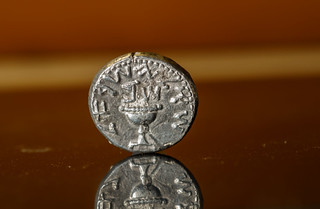 A rare silver coin from the first century was found by an 11-year-old girl volunteering in an archaeological project, the Antiquities Authority (IAA) announced on Tuesday. The coin was likely minted by a priest who joined the Jewish rebels against the Romans, which would make it one of the very few remains coming directly from the Temple.
A rare silver coin from the first century was found by an 11-year-old girl volunteering in an archaeological project, the Antiquities Authority (IAA) announced on Tuesday. The coin was likely minted by a priest who joined the Jewish rebels against the Romans, which would make it one of the very few remains coming directly from the Temple.
This is a rare find, since out of many thousands of coins discovered to date in archaeological excavations, only about 30 are coins made of silver from the period of the Great Revolt,
said Dr. Robert Kool, head of the Coin Department at the IAA.
The coin, made of pure silver, weighs 14 grams. On one side it features a cup and the inscription: Israeli shekel
and second year,
referring to the second year of the revolt (67-68 CE).
On the other side, another inscription reads Holy Jerusalem
in ancient Hebrew script, accompanied by another word that according to the experts refers to the headquarters of the High Priest in the Temple.
The coin was found by a participant in the Emek Tzurim Sifting Project, in which volunteers sift through the dirt excavated from the Pilgrimage Road.
Liel Krutokop came with her family from Petah Tikva to do archaeological sifting at the City of David.
When I got to Emek Tzurim I thought there must be simple coins in the buckets, but I did not think I would find a coin myself, and certainly not such a rare coin from pure silver,
said the 11-year-old. I was lucky to find it, but I also want to say thank you to my sister for choosing the bucket we sifted. If she had not chosen this particular bucket, I probably would not have found the coin.
To read the complete articles, see:
11-year-old finds ‘Holy Jerusalem' silver coin likely minted in the Temple
(https://www.jpost.com/archaeology/11-year-old-finds-holy-jerusalem-silver-coin-likely-minted-in-the-temple-685758)
Israeli girl finds 2,000-year-old silver coin in Jerusalem
(https://www.i24news.tv/en/news/israel/archeology/1637699892-israeli-girl-finds-2-000-year-old-silver-coin-in-jerusalem)
AARON OPPENHEIM, ARCHEOLOGIST
Aaron Oppenheim added this personal note about archeology in Israel. Thanks! Great photos. -Editor
On my visit to Israel in February 2020, I went to a location where such archeological activity is conducted and participated in the process. Here's a recap of the process from some pictures
1. Heavy equipment excavates and brings in truckloads of dirt where contents are then separated into manageable buckets
2. Each bucket is emptied into a large tray with a screen bottom and then hosed with a water spray by a volunteer
3. The water and tiny particles of dirt fall through the screen leaving 'artifacts' to be manually inspected
4. An archeologist (wearing sweatshirt with design of First Jewish Revolt prutah coin) speaks with a volunteer
5. All 'finds' are sorted into labeled buckets (metals, bones, mosaic, glass, pottery, special stones)
6. The sorted buckets are then reviewed by archeologists to identify
7. A picture of me (wearing 'Archeologist' in Hebrew and English on cap just purchased at the gift shop) looking for silver shekels! (or any coins)
PIGGYBANK FULL OF 1826 LARGE CENTS
In his Stack's Bowers blog Dave Bowers published an interesting article about Oscar Schilke's find of a Boston cache of Large Cents of a single date. -Editor
The late Oscar G. Schilke lived on the shore of Dodge Pond in Niantic, Connecticut, in the 1950s and 1960s. Prominent on the numismatic scene for many years beginning in the early 1930s, he would often set up exhibits in banks. These displays served to attract customers to the financial institutions, and for Oscar, it meant getting leads which often resulted in his acquiring choice pieces for his collection.?
On one particular day a gentleman told him that in the course of doing some work in the Boston harbor area, he came across what was left of an old building which was once the office of a customs agent or toll-taker of some kind—the informant was not sure. In any event, cemented into the floor of the structure was a little metal vault or strong box which, through an opening, appeared to contain a bunch of old coins.?
Oscar went to Boston with the gentleman in question, and after some effort, pried the top off the box revealing an early-day version of a piggy bank. All in a heap were dozens of large cents dated 1826, and no others. Grades ranged from worn nearly smooth on up to lustrous Uncirculated, or close to it. Apparently, some long-forgotten person once took a fancy to this particular date and each time an 1826 cent was found in the course of commerce it was dropped through a slot in the floor into this tiny chamber. As large cents did not circulate much after 1857 and not at all after the summer of 1862, presumably this cache was formed in the 1840s or 1850s, after which it was untouched for the best part of a century.
Perhaps the original depositor passed away and never told anyone about the cents, or perhaps he realized that their value was insufficient to warrant tearing up the floor. For several years afterward, Oscar Schilke had a good trading stock of cents of this date.
In the 2021 Guide Book of United States Coins an MS-60 1826 large cent is listed at $600; an AU-50 at $300, an EF-40 at $150, and a G-4 at $55. The 1826 large cent had a mintage of 234,000 pieces.
To read the complete article, see:
A Cache of 1826 Large Cents Hidden in the 1800s
(https://www.stacksbowers.com/News/Pages/Blogs.aspx?ArticleID=a-cache-of-1826-large-cents-stacks-bowers-galleries)
Dave's books and articles have been around as long as most of us have been in numismatics, and have opened new collecting horizons for many. The hobby can never thank him enough. In the December 2021 issue of The Numismatist Dave announces the end of his long-running column in the American Numismatic Association publication. But every end is a new beginning, and we can all look forward to future articles from a new team of numismatists. -Editor
... having recently turned 83, it seems only natural to pass the torch to the inspiring young numismatists (YNs) at the forefront of the next generation of collecting. While I will never be finished with numismatics, my family and I look forward to a more relaxed schedule, one that has fewer deadlines, more time for spontaneous activities and even the opportunity for some downtime.
It is with great pleasure and
optimism that I introduce you to
the incredible team that will share
this column space in the months
to come. The YN Perspective
will be written by four former
YNs—Abby Zechman, Kenny
Sammut, Livia Paoletti and Kellen Hoard. Each will write three
articles per year, providing a variety of perspectives and guidance
on topics that are relevant to today's young collectors.
I am excited about this fresh approach and look forward to reading their opinions about the hobby and the new directions it may take. And, while much has changed about collecting, I truly believe that the spirit and enjoyment of numismatics that will be reflected in this new column will not be all that different from what I felt more than 60 years ago when I was a young numismatist.
ALASKA PREPPER TOKENS
Dick Hanscom edits the Alaskan Token Collector & Polar Numismatist, an excellent publication. The November/December 2021 issue includes a nice article about tokens Dick made for his friend Rudy, the "Alaska Prepper".
There are many views and definitions of the terms "survivalist" and "prepper". Both like to be prepared for unforeseen future events, learning useful skills and stocking up on all manner of foodstuffs and supplies. Extreme survivalists build bunkers and stock ammunition for the apocalypse, but also plan for evacuation and life on the move. Preppers are closer to the mainstream, planning to ride out difficulties in place (but with go-bags packed and ready just in case). My mother was the Depression-child version of a prepper before the word was invented, stockpiling dozens of cans of every favorite soup or side dish so as never to run out. I envy the experienced prepper - we've never been that organized. But I guess I'll have enough coin books to read if I don't break my glasses fighting off zombies.
Anyway, with permission we're republishing the complete article here. Many thanks to Dick for providing the text and images. -Editor
ALASKA PREPPER/NUTRIENT SURVIVAL
As you read in the April issue, Rudy, the Alaska Prepper, gifted me one ounce of silver. So, in return, I gifted him ten 1/10 oz. silver Alaska Prepper tokens. I created a monster! He liked them so much he ordered 100. And then 100 more.
Rudy asked if I could make a 1 oz. silver token. I did this for him. It is not my best work. Only 7 were minted.
Being the devious soul that I am, I thought I would yank Rudy's chain again. I had made a 1 DWT Alaska Gold die with a moose for future use. I had some spare 1 DWT gold blanks just lying around... So I paired this die with the Alaska Prepper snow flake die and made a gold token. The next time he came in the store, I casually tossed it on the counter. Cast the line, set the hook! I didn't expect to sell him many, but I did expect to sell the piece I tossed on the counter. Only 2 of these were pressed - one for him and one for me.
Rudy's YouTube channel has become very successful. He has over 100,000 subscribers. Being a
prepper,
he is always looking at long term storage
foods. He has become affiliated with Nutrient Survival. Unlike most long term storage foods that are
pretty much empty calories - and don't get me wrong,
calories are king when you need food - Nutrient Survival foods are nutrient dense.
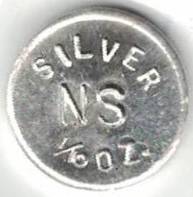 So Rudy convinced Nutrient survival that they needed
to make up a special
So Rudy convinced Nutrient survival that they needed
to make up a special Alaska Prepper Pack.
It included six #10 cans of their most popular products.
A special discount was extended through Rudy. Plus,
he convinced them that they needed to throw in a 1/10 oz. silver Alaska Prepper token with a special
NS
reverse. This special was limited to 100 special Alaska Prepper Packs
, and each contained a 1/10 oz. silver token.
Rudy continues to work with Nutrient Survival. He liked the moose die so much, he had me make an Alaska Prepper die with the moose to replace the snowflake. And this die was used on the next Nutrient Survival Alaska Prepper offer.
In this special offer, Nutrient Survival was giving away 1 DWT Alaska gold tokens randomly to three of the first 100 purchasers.
In addition, Rudy ordered 100 of the AP Moose and NS 1/10 oz. silver tokens. This time, he will be sending them directly to the purchasers of the NS AP pack. But there was a problem. The first 100 special NP AP packs sold out in 2 hours. Rudy asked if I could make another 100, and have another 100 blanks in reserve.
On the first NS 1/10 oz., I noticed that the 1/10 was a
bit weak. I decided to repunch the 1/10 and strengthen
it. Only two were made with the weak
1/10 die.
As I was melting and pouring silver on the Sunday of
Labor Day weekend, Rudy called and said, Dick, I
need 200, not 100. And I will probably need another
100.
He picked up the first 200 Tuesday after Labor day.
While the special NS AP special offer was supposed to be only 100 units, Rudy convinced them that they needed to extend it through the month of September. As the promotion has now ended, I made 354 tokens for Rudy.
And the good news is that the dies seem to be holding up well. The silver is thick (about 1.85mm) so it absorbs the pressing well without doing too much die deformation. I just have to flatten the ends occasionally (50-100 pressings).
Now I just have to get the Toyo stove hooked up in the workshop so I can keep doing this in the winter.
Dick adds:
"Rudy's YouTube channel is Alaska Prepper. This video shows Rudy in my "Mint." DIY: HOW TO MINT A SILVER COIN FROM START TO FINISH."
For subscription information, contact Dick at akcoins@mosquitonet.com . -Editor
WHAT IS A MODERN COIN?
Here are a couple of items relating to modern coinage. The first is an article on Cosmos of Collectibles by Daniel Baumbach titled "What Is the Difference Between a Coin, a Commemorative Coin and a Medal?" The second item is a CoinWeek podcast interview with representatives from CIT, maker of a plethora of modern medallic issues using advanced minting techniques. -Editor
What Is the Difference?
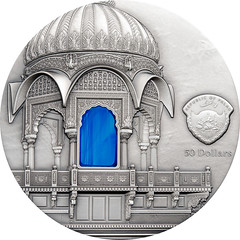 Structuring the world of modern coins isn't that easy. Just some of the items laymen classify as coins are actually coins. In addition, there are special and hybrid forms and all kinds of unclear terms such as commemorative coin, collector coin, NCLT, bullion coin etc. Which types of coins exist? We present an overview.
Structuring the world of modern coins isn't that easy. Just some of the items laymen classify as coins are actually coins. In addition, there are special and hybrid forms and all kinds of unclear terms such as commemorative coin, collector coin, NCLT, bullion coin etc. Which types of coins exist? We present an overview.
Let's start with the typical form of a coin: circulation coins are coins issued by a state. They are legal tender with a face value and usually feature the name or the symbol of the issuing nation, for example the portrait of the monarch. They circulate as genuine
coins in the respective issuing country or monetary union and can be used to pay at any time without a problem – provided that they aren't old coins that lost their status as legal tender.
To read the complete article, see:
What Is the Difference Between a Coin, a Commemorative Coin and a Medal?
(https://cosmosofcollectibles.com/what-is-the-difference-between-a-coin-a-commemorative-coin-and-a-medal/)
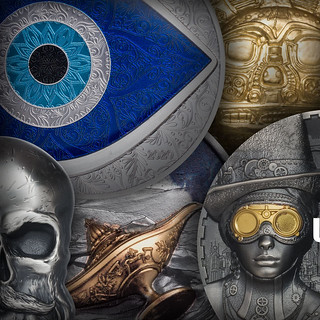 Ultra-Modern Coins Take Over
Ultra-Modern Coins Take Over
This week on the coinweek podcast we are going to have a lively, interesting, and provocative conversation with Chang Bullock and Orlando Lorenzana of CIT, where we talk about how ultra-modern coins have taken over the contemporary coin market and how CIT's innovations in color and coin minting technology are changing the game for private and sovereign mints. You cannot walk away from this podcast without learning something about the way minting has changed and we hope it will give you a clearer picture of where we are heading.
To read the complete article, see:
CoinWeek Podcast: Ultra-Modern Coins Take Over
(https://www.podomatic.com/podcasts/coinweek/episodes/2021-03-30T13_00_40-07_00)
FLOODING THREATENS SMITHSONIAN
Len Augsburger passed along this scary New York Times story about the rising threat of flooding at the Smithsonian museums in Washington, D.C. He notes: "Most of the National Numismatic Collection is on the fourth floor of the National Museum of American History in the curatorial area. The public exhibit is on the first floor." See the full article online for some great photos. -Editor
President Warren Harding's blue silk pajamas. Muhammad Ali's boxing gloves. The Star-Spangled Banner. Scripts from the television show "M*A*S*H."
Nearly 2 million irreplaceable artifacts that tell the American story are housed in the National Museum of American History, part of the Smithsonian Institution, the biggest museum complex in the world.
Now, because of climate change, the Smithsonian stands out for another reason: Its cherished buildings are extremely vulnerable to flooding, and some could eventually be underwater.
At the American History museum, water is already intruding.
So far, the museum's holdings have escaped damage. But we're kind of in trial and error,
said Ryan Doyle, a facilities manager at the Smithsonian. It's about managing water.
An assessment of the Smithsonian's vulnerabilities, released last month, reveals the scale of the challenge: Not only are artifacts stored in basements in danger, but floods could knock out electrical and ventilation systems in the basements that keep the humidity at the right level to protect priceless art, textiles, documents and specimens on display.
Of all its facilities, the Smithsonian ranks American History as the most vulnerable, followed by its next-door neighbor, the National Museum of Natural History.
To read the complete article, see:
Saving History With Sandbags: Climate Change Threatens the Smithsonian
(https://www.nytimes.com/2021/11/25/climate/smithsonian-museum-flooding.html)
LOOSE CHANGE: NOVEMBER 28, 2021
Here are some additional items in the media this week that may be of interest. -Editor
Dealer Frank Robinson attended the recent Baltimore Expo and wrote about his experience, including this nice acquisition. -Editor
... a dollar-sized Byzantine bronze of Emperor Tiberius Constantine (578-82 AD). The big M signifies the denomination (follis); the u
the regnal year (fifth). CON is the mint, Constantinople; the Gamma after it, the officina
or division in the mint. It was $200, actually the most I ever paid for a Byzantine bronze; but the quality is great. I was very glad to get it.
Quality is the name of the game.
To read the complete article, see:
Baltimore Coin Show Fun
(https://rationaloptimist.wordpress.com/2021/11/22/baltimore-coin-show-fun/)
Ted Banning passed along this article on the origins of money. Thanks. -Editor
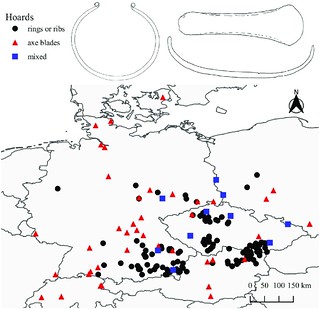 The origins of money and the formulation of coherent weight and measurement systems are amongst the most significant prehistoric developments of the human intellect. We present a method for detecting perceptible standardization of weights and apply this to 5028 Early Bronze Age rings, ribs, and axe blades from Central Europe.
The origins of money and the formulation of coherent weight and measurement systems are amongst the most significant prehistoric developments of the human intellect. We present a method for detecting perceptible standardization of weights and apply this to 5028 Early Bronze Age rings, ribs, and axe blades from Central Europe.
We calculate the degree of uniformity on the basis of psychophysics, and quantify this using similarity indexes. The analysis shows that 70.3% of all rings could not be perceptibly distinguished from a ring weighing 195.5 grams, indicating their suitability as commodity money. Perceptive weight equivalence is demonstrated between rings, and a selection of ribs and axe blades. Co-occurrence of these objects evidences their interchangeability. We further suggest that producing copies of rings led to recognition of weight similarities and the independent emergence of a system of weighing in Central Europe at the end of the Early Bronze Age.
To read the complete article, see:
The origins of money: Calculation of similarity indexes demonstrates the earliest development of commodity money in prehistoric Central Europe
(https://www.researchgate.net/publication/348642887_The_origins
_of_money_Calculation_of_similarity_indexes_demonstrates_the_earliest_
development_of_commodity_money_in_prehistoric_Central_Europe)
This article from the Baldwin's blog discusses a coin motif I've always been curious about - the man-headed bull. Check it out. -Editor
Of all the mythical beasts to appear on coins from the ancient world, the man-headed bull must rank among the most bizarre. These strange beasts were usually river-gods, the power of a raging bull equating to the relentless power of a fast-flowing river.
Achelous was the chief river-god of the Greek pantheon. Son of the Titans Oceanus and Tethys, he appears in various forms throughout ancient material culture, including a bearded man and a bull, and sometimes a combination of the two. The Achelous river, which formed the border between Akarnania and Aetolia, was the largest river in Greece, thus making the river god the most important in Greek mythology.
Coins from Akarnania depict the god in his man-headed bull form, including coin #23 from our Christmas Fixed Price List. This silver stater, minted in Leukas, which was a part of the Akarnanian Confederacy, features a close-up of Achelous' head, clean-shaven and with horns. Behind his head is the name of the magistrate in ancient Greek – ?YKOYPGOS, or Lykourgos. This coin was minted around 250-200 BC. Its reverse depicts the god, Apollo, seated left on an ornately decorated throne, along with the name of the confederacy.
To read the complete article, see:
THE MAN-HEADED BULL
(https://www.baldwin.co.uk/news/the-man-headed-bull/)
FEATURED WEB SITE: CRANE MUSEUM OF PAPERMAKING
This week's Featured Web Site is the Crane Museum of Papermaking. Found via News & Notes published by the Society of Paper Money Collectors (Volume VII, Number 23, November 23, 2021).
The Crane Museum of Papermaking is located in what was the rag room of Crane's Old Stone Mill, dating back to 1844. This was the first mill built by the second generation of Crane papermakers in Dalton, Mass.— Zenas Marshall and James Brewer Crane, following the retirement of the pioneer papermaker Zenas Crane.
The Museum opened in 1930 after an extensive renovation, making it one of the oldest corporate museums in the country. The grounds were designed by the F.L and J.C Olmsted firm. Exhibits in the Museum trace the 250-year history of Crane papermaking from The Liberty Paper Mill in Milton, Mass., which operated from 1770 to 1793, to the present. The Liberty Mill was indeed a cradle of the American Revolution, serving such revolutionary luminaries as Paul Revere, Henry Knox, John Hancock and a host of others responsible for today's freedom.

